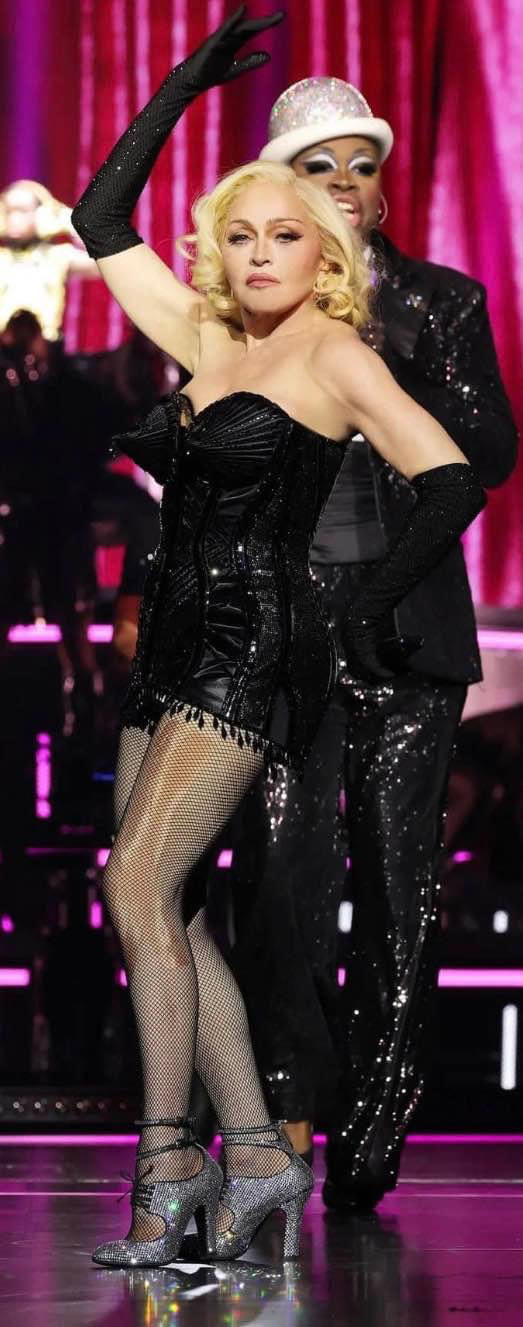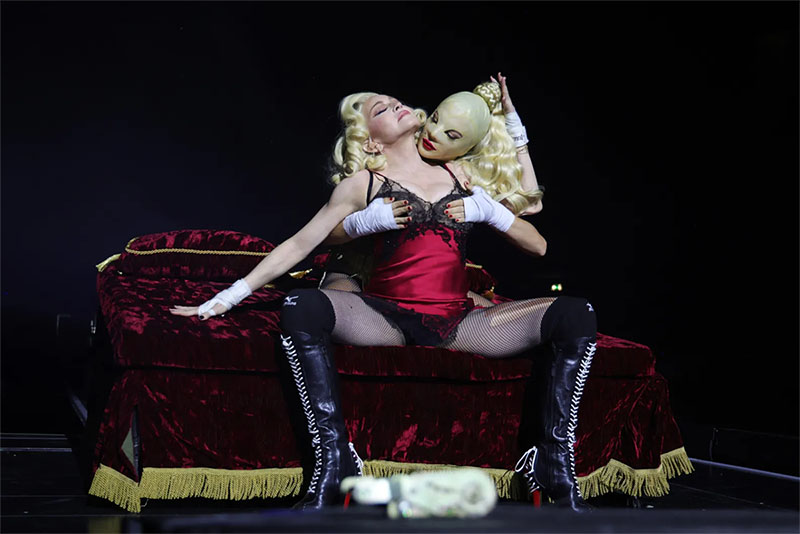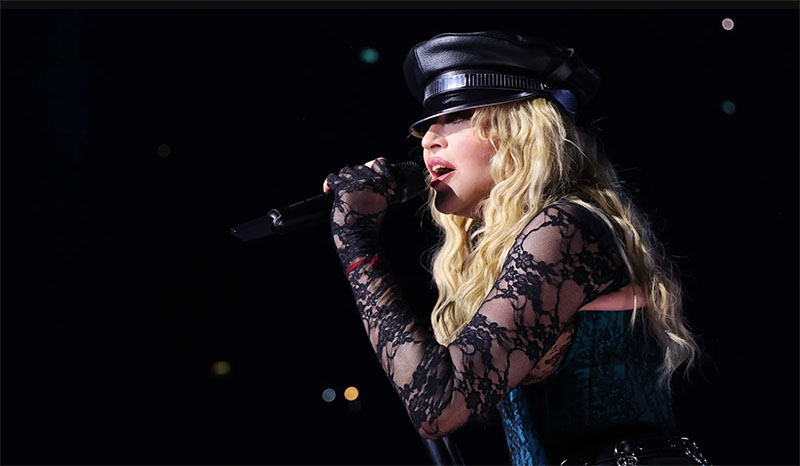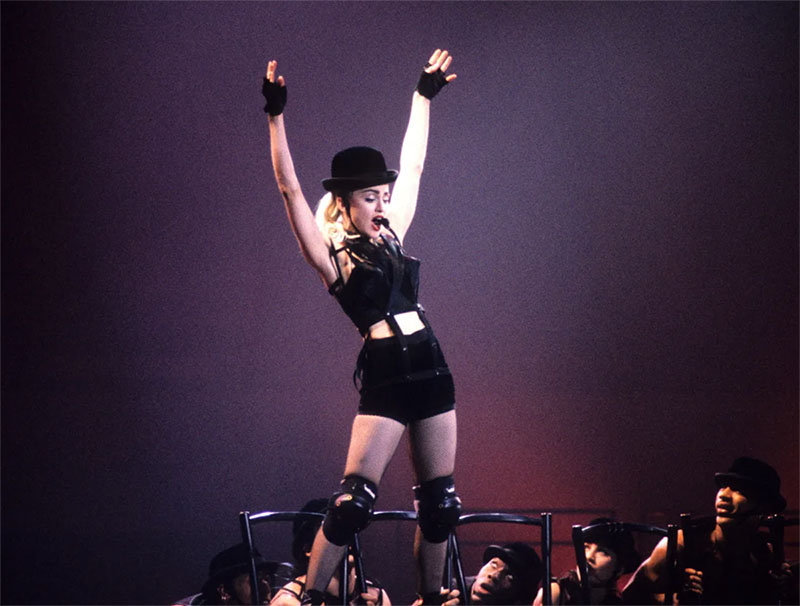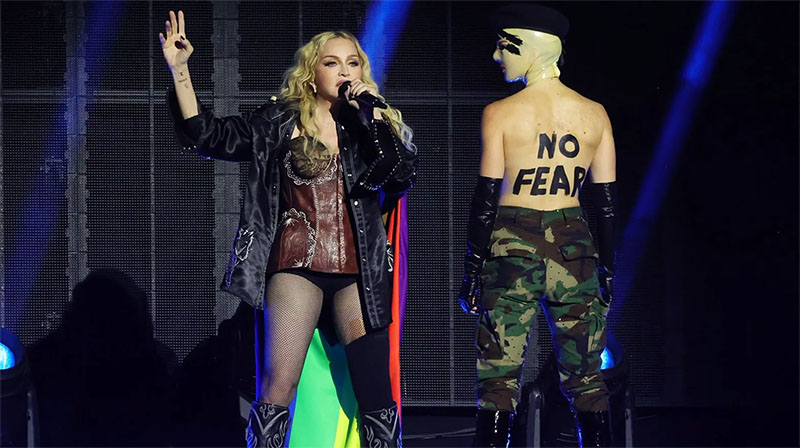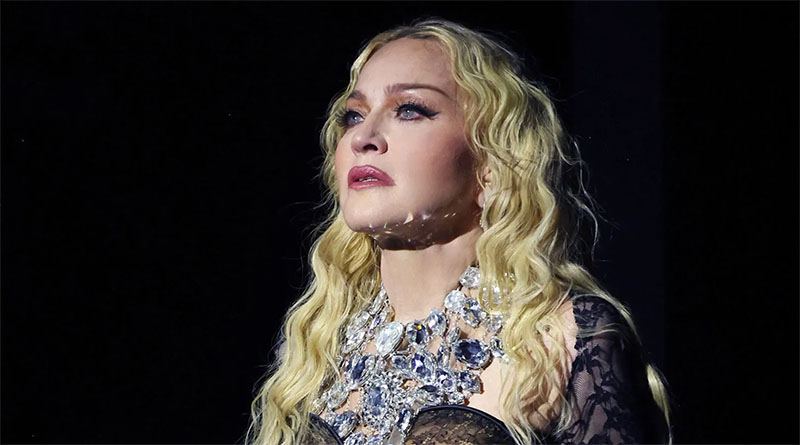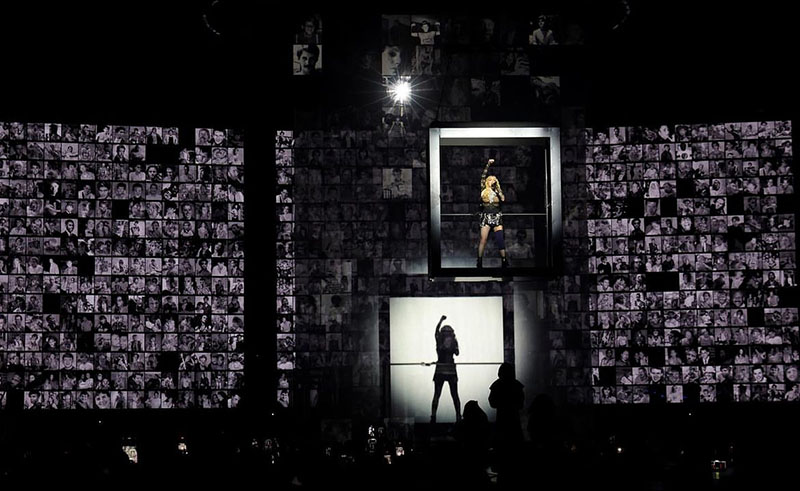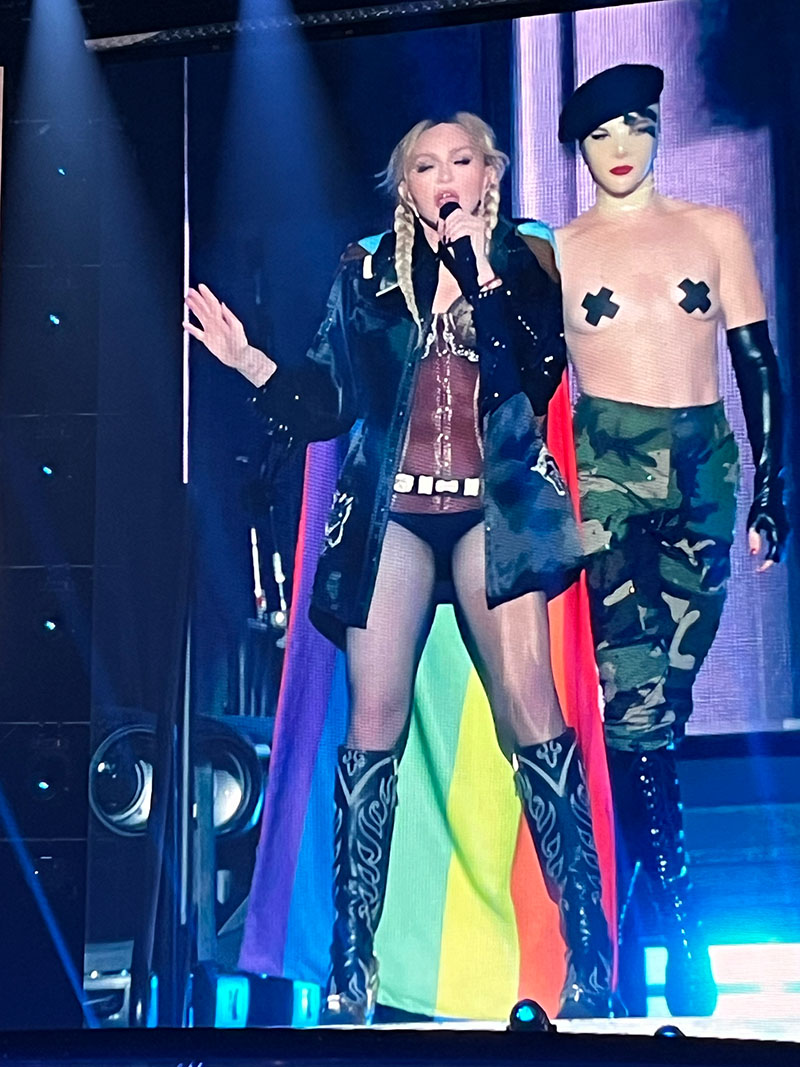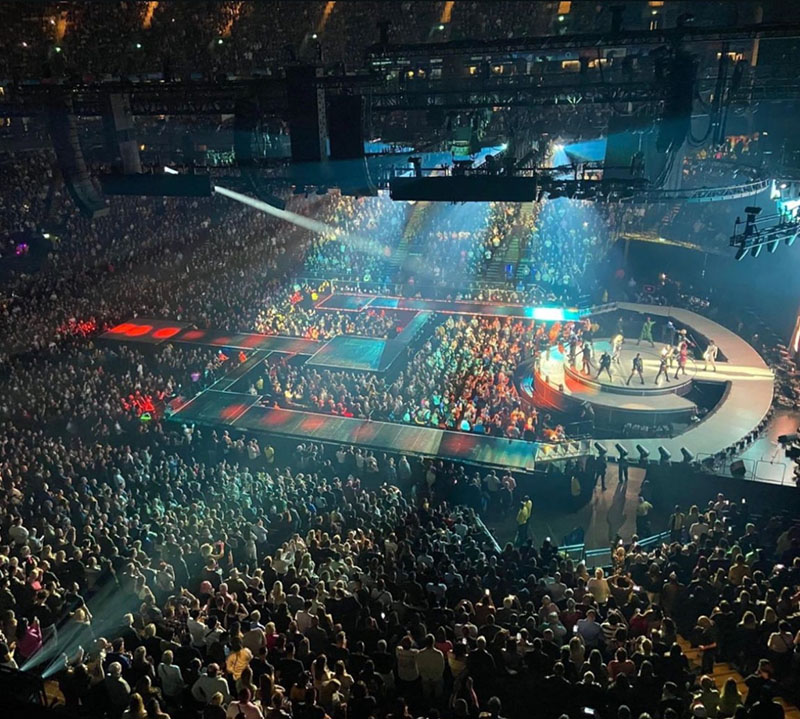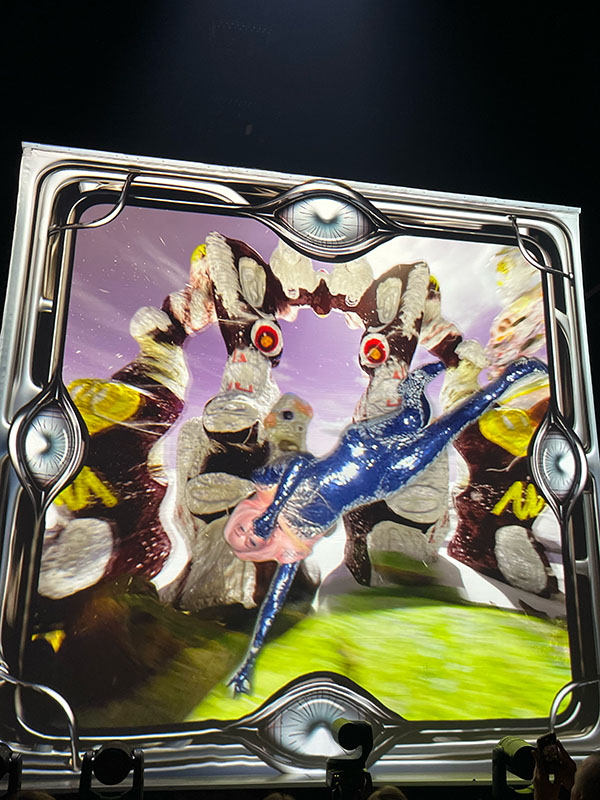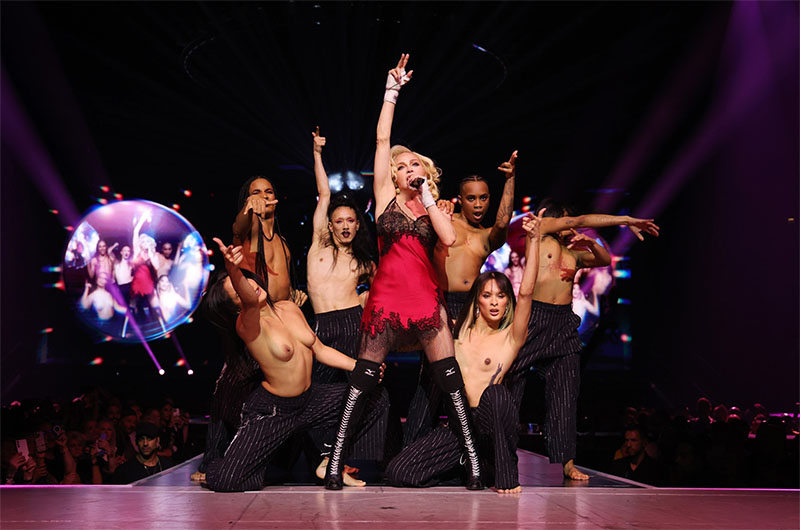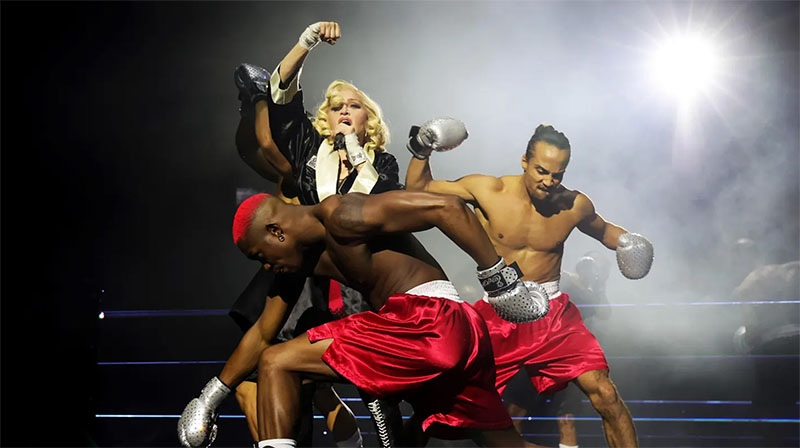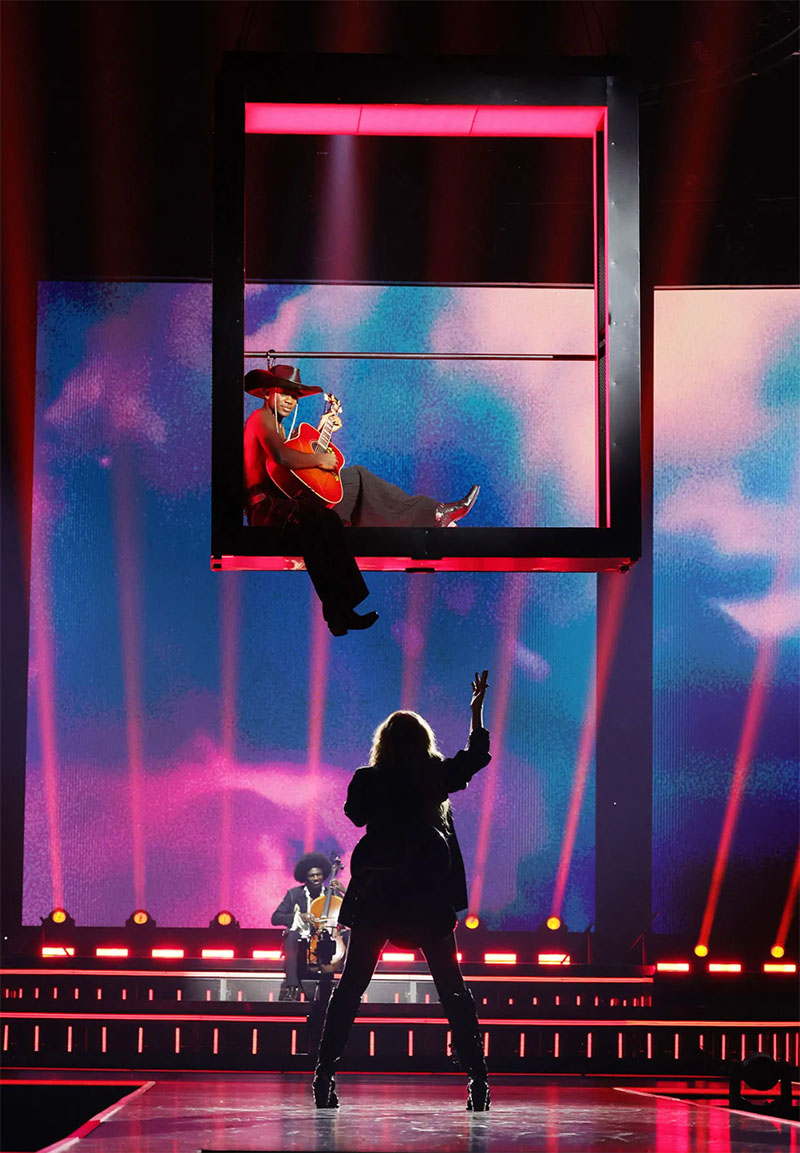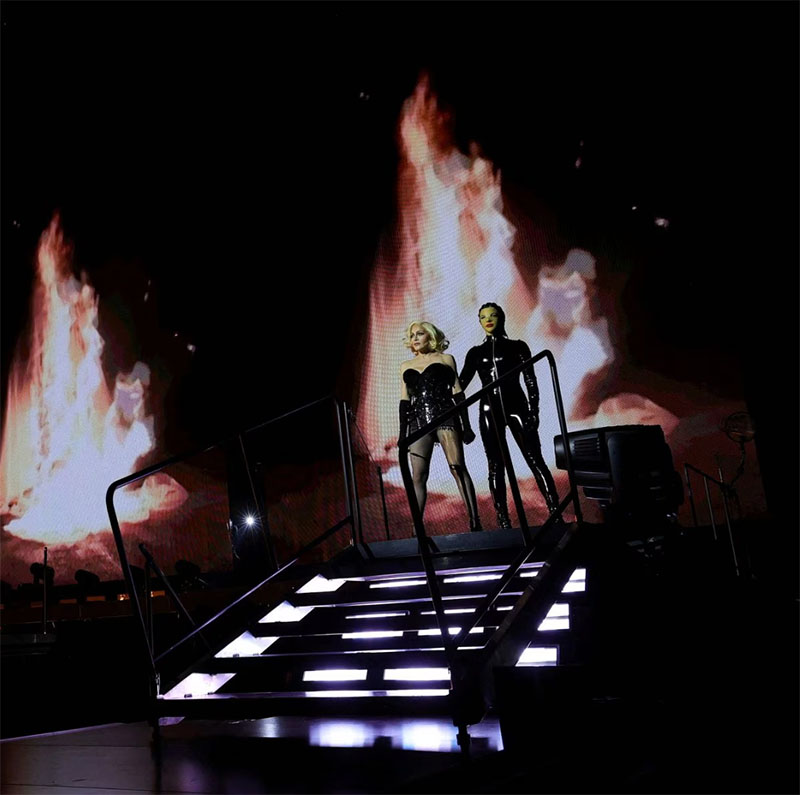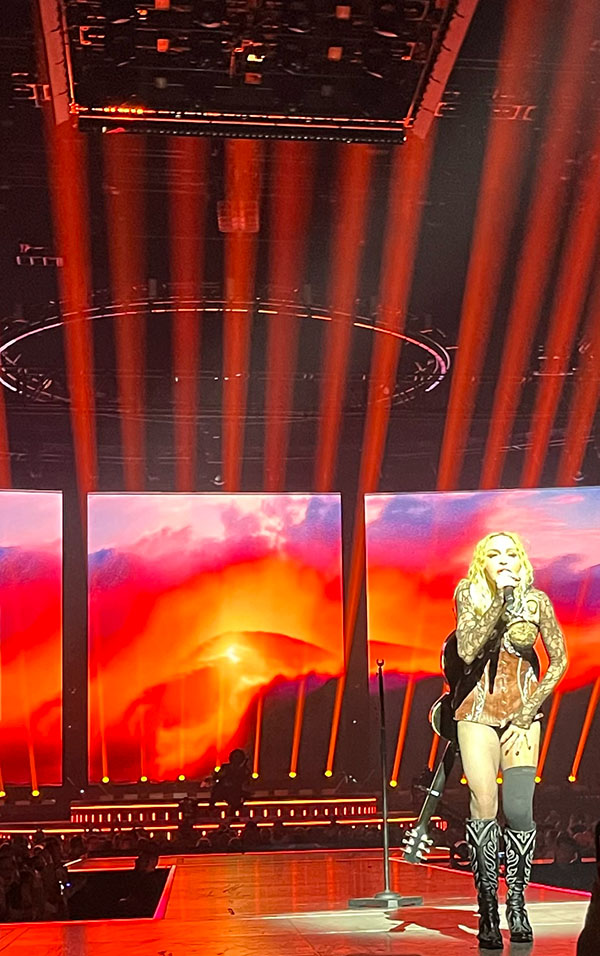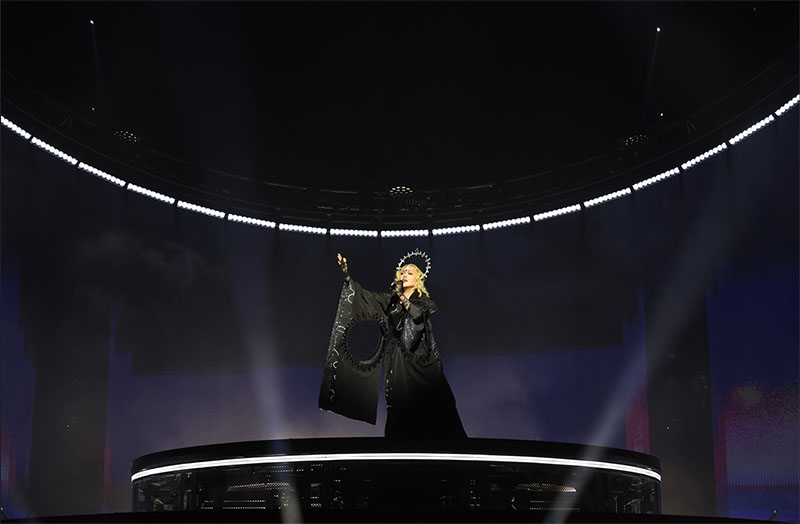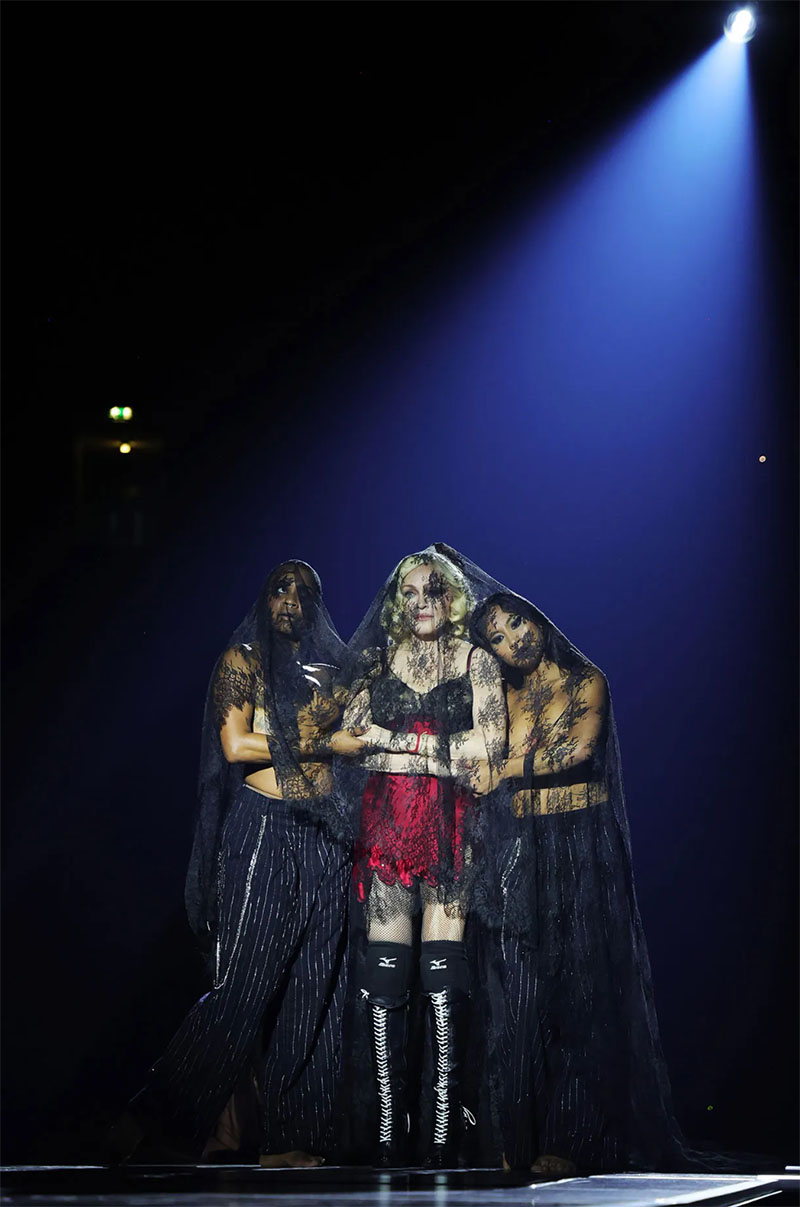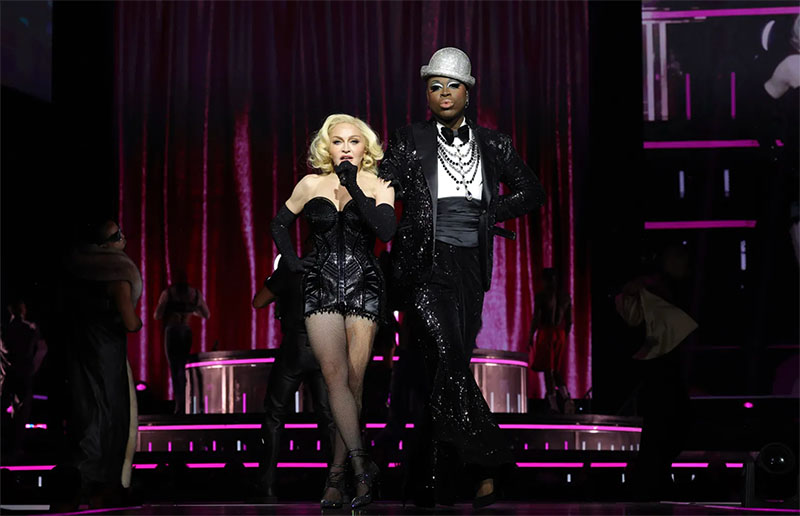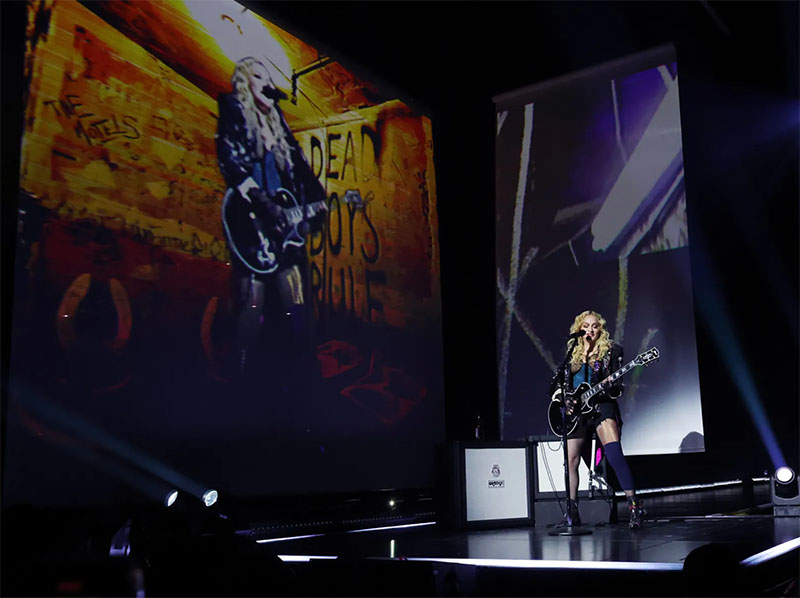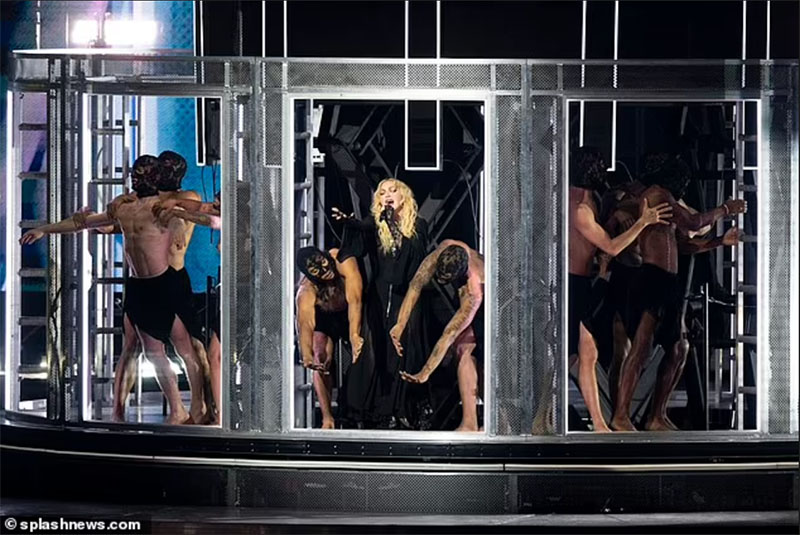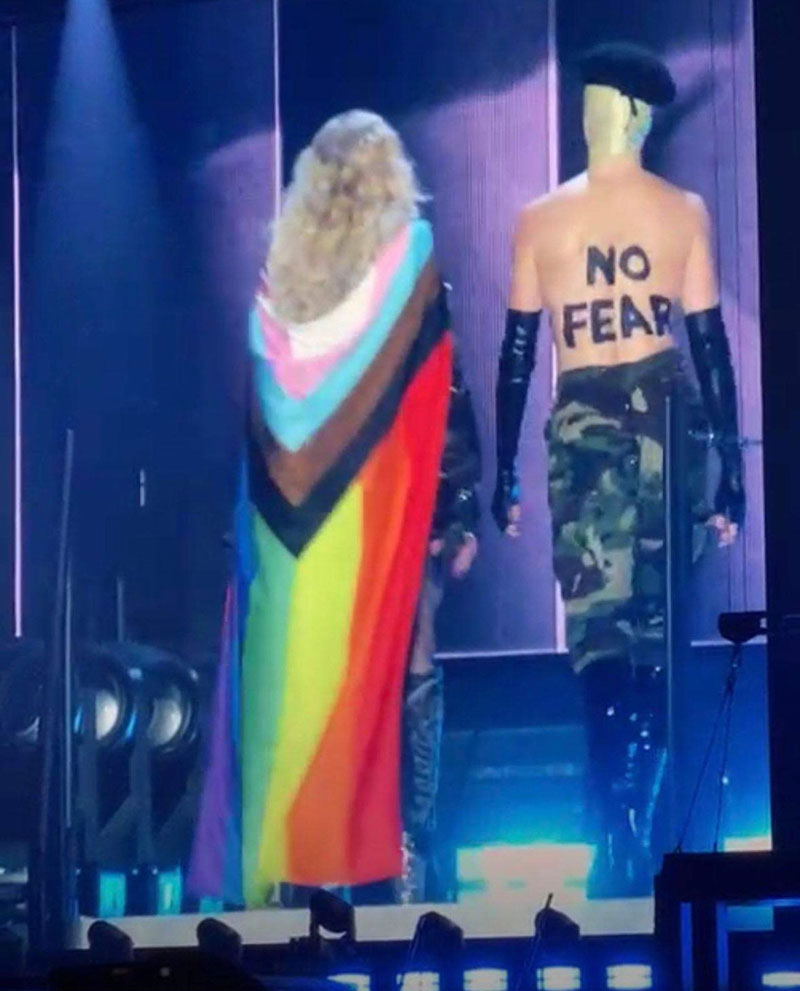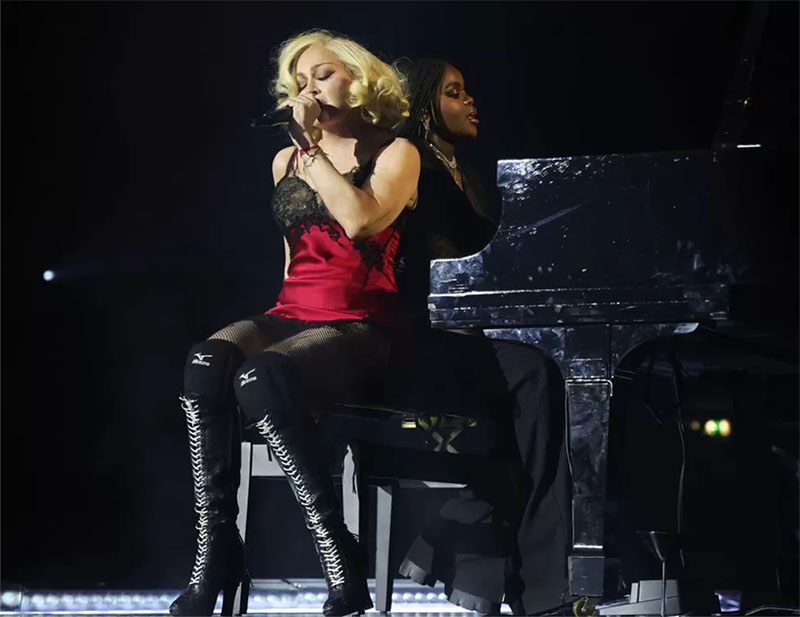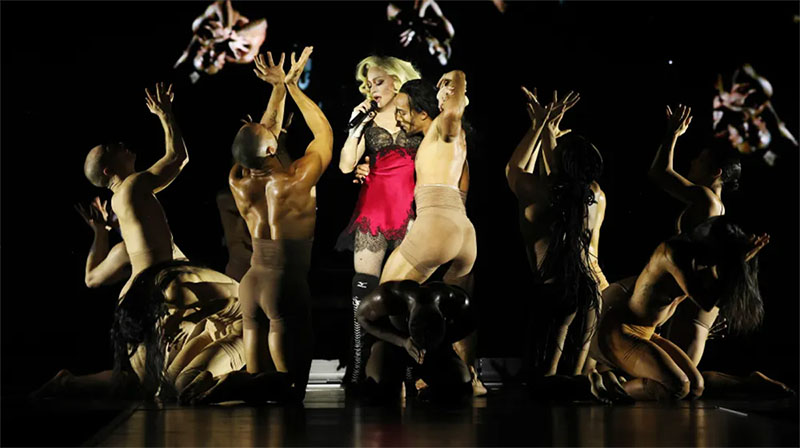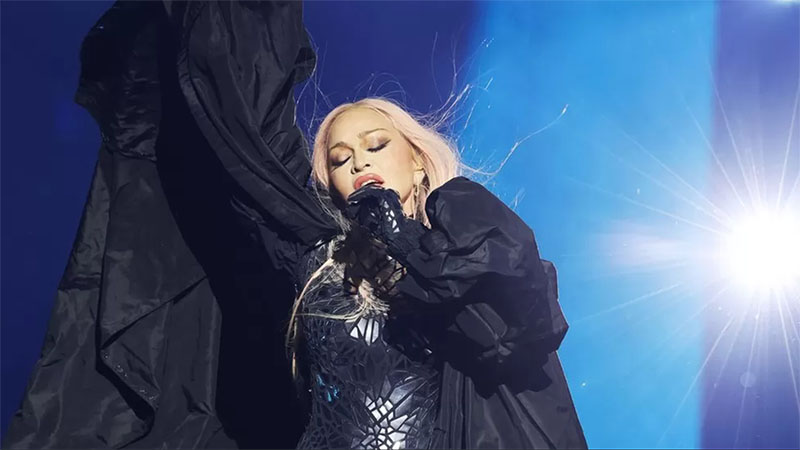|
|
Celebration Tour press - Europe
← Back to Celebration Tour overview
Forgive me for doubting, Madonna: you are still a sister in arms
Source: The Telegraph - 11 Dec. 2023Maggie Alderson
I owe one Ms Madonna Louise Ciccone a big apology. I had dismissed her and declared her irrelevant. A traitor even. And I was wrong. So wrong.
After adoring her in my twenties and thirties – seeing her at Wembley in 1987 – I had no interest in shelling out bundles of cash this time around, to see the now 65-year-old "Queen of Pop" on her latest Celebration Tour.
I'd seen the video of her tripping on a stupid cloak and falling off a stage. I'd seen her muttoning it up in the kind of corsets she'd made iconic in her prime. I'd seen the wrinkled-old-hands covered with gloves, which she adopted at a much younger age than Karl Lagerfeld did.
Worst of all I'd seen the Wildenstein plastic surgery – and I took it personally.
Looking at those pictures of the polyester pillow lips and wipe-clean cheek implants, I felt betrayed.
Born just one year before me she was a trailblazer for showing how a woman can own and control her success. Which was particularly impressive in an industry where so many young women are egregiously exploited and manipulated – some by their own fathers, hello Britney, hello Amy.
In stark contrast even to Taylor Swift, she's always kept a tight grip on her creative and management processes. Alongside being a constantly evolving, boundary-pushing artistic genius.
For all those reasons, I always thought Madonna was going to be the one to show my generation of women how to grow old with cool style. Instead, she seemed to be going down the Hollywood Boulevard route, but in public.
Apparently so desperate to retain the male gaze in later life she seemed to have mutilated herself in the deluded pursuit of youthful appearance. Far from looking young, she looked grotesque in those pictures.
I felt betrayed, because – born a year apart – we kind of grew up together and I'd thought we were sisters in arms in the more nuanced second-wave resistance to the patriarchy. So, it was bewildering when she seemed to have gone over to the other side, lip implants first.
Especially from a woman who collects artworks by Frida Kahlo, Cindy Sherman and Jenny Holzer.
But on Tuesday night I went – almost accidentally, a friend had a spare ticket, so I pulled myself off the sofa and strolled along – to Madonna's show at the O2.
I left feeling I might have been to the greatest concert of my life. (And I saw Blondie at the Marquee in 1977.)
Now I'm wondering if those plastic surgery pictures that upset me so much had actually been photoshopped.
Seeing her in real life, while she does have a forehead and cheeks as smooth as a crash helmet, she doesn't have one of those weird American plastic flange faces, as she appears to in the infamous shots. She still looks like Madonna. With a slightly Barbie-doll finish admittedly, but still our Mads.
And in the context of her show, her surgically and chemically adjusted features didn't seem jarring at all. It's showbiz. All part of the razzle dazzle.
Because far more than just a creator of timelessly brilliant pop songs – and wow, did they stand up to scrutiny on Tuesday night – Madonna has always been a performer.
Just as in her 40-year oeuvre of iconic music videos, on stage she's a creator and a curator of visual astonishments.
The whole theatrical spectacle of the Celebration show, compered by a larger-than-life drag queen (RuPaul's Drag Race winner Bob the Drag Queen) wearing an oversized version of her Marie-Antoinette costume, was about chimeric artifice.
Everything on her stage was fluid, from the expressions of her own sexuality to the gender of her dancers. At one point they were all nearly naked and some that you might have thought were men had breasts and some you might have thought were women, didn't.
At one point Madonna snogs one of them with commitment. Gender mutable and completely irrelevant – and everything much more interesting for it.
Later in the show species also becomes fluid as she turns into an alien, in a skintight faceted metallic Versace-does-Barbarella catsuit, her image transposed onto a fantastical Avatar-esque distant planet landscape on the giant back screen.
She sang that entire song on a raised platform lying down, which I thought was pure genius for an artiste more than eligible for a London transport travel pass.
She does a lot of her amazing dancing in the show with a company young enough to be her grandchildren, so seamlessly factoring in a few rest periods for the older star was very smart.
For the same reason, she wears a knee support throughout the show, even with the skimpiest Gaultier corset costume. There's no sad attempt to conceal it, instead she proudly owns it: I'm 65 years old, I've been dancing all my life, one of my knees gives me jip. Have you seen my upper arms…?
And it's that combination of strength, fearlessness and sheer pragmatism, with sublime style and artistry that makes me admire her just as much now, as I did forty years ago.
Towards the end of the show phrases appear on the big screen, Jenny Holzer style. "NO FEAR" said one, which was more than apparent to everyone watching – and "TO AGE IS A SIN" was another.
Tears filled my wrinkled and presbyopic 64-year-old eyes as I read that (happy it was in large print). Those five short words summed it all up.
In our culture women now have equal rights in law, MeToo has done its bit and women occupy many significant senior roles. We've had three women prime ministers in this country. But still those words are true – for women, to age is still a sin.
Standing there watching my contemporary entrance 20,000 people – the vast majority of them much younger than me – once again it was Madonna kicking back at the rules and changing the status quo through sheer talent and bravura – and no fear.
Which made me think, as I got ecstatically into the groove with the young women on either side of me, the traitor wasn't Madonna, for having plastic surgery – but me, for believing the propaganda that she was ridiculous and laughable and irrelevant for having done so; a silly old woman.
When, in fact, Madonna Louise Ciccone chose to have some facial adjustments for one reason and one reason alone – because she wanted to.
And for continuing to live by only her rules, the Queen of Pop remains not only relevant, but a trailblazer for all women who don't want to be told what to do. She's still my sister in arms. Except, her arms are so much better than mine.
The Celebration Tour is her most radical LGBTQ statement in decades
Source: CNN - 9 Dec. 2023Mary Gabriel
As Madonna brings The Celebration Tour to New York from Europe for the start of a 52-date North American journey next week, she leaves behind a trail of headlines as long as an asteroid's tail. There are stories about her remarkable recovery from a life-threatening illness; stories about her fans' delight that she has finally given them what they have clamored for — a greatest hits tour. And, of course, countless stories dedicated to her wardrobe, her appearance and her personal life.
Largely missing, however, in all that coverage, is a mention of the tour's political and social significance: "Celebration" is Madonna's most radical concert statement in support of the LGBTQ community since her paradigm-shifting "Blond Ambition Tour" in 1990, and perhaps her most radical stage performance ever.
At a time when LGBTQ rights are under threat globally, and as US groups supporting those rights issue unprecedented alerts warning of rising assaults, both legislative and physical, Madonna has produced a concert that not only embraces and reassures the gay and trans community, but introduces audiences to the world as she sees it. And it is a remarkable place indeed; a moving, pulsating spectrum of humanity in all its glorious otherness.
Madonna's show, emceed by Bob the Drag Queen, can only be described as post-gender. The designations "man" and "woman" are irrelevant. The usual markers that indicate male and female are either eliminated or exchanged. Women have shaved heads, men have long hair; women wear trousers, men dresses; both perform topless and yet there is nothing prurient about seeing a woman's breasts — no more so than a man's. In the world that Madonna envisions, a person isn't either/or, they are whatever they want to be. They are themselves; legislators be damned.
"The show is one big statement for freedom and learning to love yourself for who you are and to not give up the fight in being yourself and thus having no fear," Kimberly van Pinxteren, the webmaster of the fan site MadonnaUnderground, told me. She has seen nine Madonna tours, for a total of 83 shows, and considers "Celebration" to be the artist's most powerful affirmation of LGBTQ rights in decades.
Every Madonna concert since 1990 has included LGBTQ elements and tributes, some more direct than others. In 2012, for example, during her MDNA tour's stop in St. Petersburg, Russia, she challenged that city's ban on "gay propaganda," which she called "a ridiculous atrocity" on her Facebook page, by delivering a defense of gay rights from the stage and distributing rainbow posters emblazoned with the words "No Fear" to concertgoers. (Dozens of concertgoers were arrested and she was sued for more than $10 million by activist groups for "moral damages," among other perceived transgressions. The lawsuit was dismissed later on.) But only twice in Madonna's long career has queer and trans culture been the central focus of her show.
The first was in 1990. Madonna's "Blond Ambition Tour" occurred at a time when gay men were dying by the tens of thousands from AIDS. Rather than receive help or comfort, they were largely shunned and shamed. The undercurrent of homophobia that permeated society prior to AIDS began to be expressed openly, and cruelly. When gay men were mentioned in the press, the narrative was about death and the subtext of much of the commentary was that they deserved it. "Blond Ambition" helped change the story.
On stage with Madonna were seven male dancers, only one of whom was heterosexual and three of whom, though she didn't know it at the time, were HIV positive. The tale she and they told through music and dance was one of life and joy. Her dancers were beautiful, powerful, funny, sexy young men who inspired audiences as much as she did. In fact, they became celebrities as the tour traversed the globe. And when it was over, gay men everywhere could see themselves in those dancers and feel empowered. Many heterosexuals saw gay men differently, too.
Not everyone was convinced. Pope John Paul II called the tour "one of the most satanic shows in the history of humanity." But the conversation had begun, fear dissipated, closet doors opened. "Madonna 100% helped change the narrative," Brad Mayer of the Human Rights Campaign (HRC), the largest LGBTQ civil rights group in the United States, told me. "She saw the beauty of people in our community and their contributions. And, so yeah, Blond Ambition was huge."
Matthew Rettenmund, a writer who has seen every Madonna concert except her first, called the "Blond Ambition" message "very subversive" and a direct response to the times.
Now, decades later, the times called for another such message. In response, Madonna mounted "Celebration," her second concert with LGBTQ rights at its core.
In its 40 years in operation, the HRC has only issued one emergency declaration and that was this past June. State legislatures at that point had passed a record 76 anti-LGBTQ bills out of the 525 that were introduced in 41 states in the first six months of 2023. From "don't say gay" laws to book and bathroom bans, those most impacted by the measures, according to HRC, were children. The Williams Institute at the UCLA School of Law found that around one third of high school aged transgender youth live in states that prevent them from playing sports and HRC Foundation data determined that around one third of transgender youth aged 13-17 live in states that ban their much-needed medical care.
The Gay and Lesbian Alliance Against Defamation (GLAAD), the world's largest LGBTQ media advocacy group, issued a similar series of red alerts this year, most recently last month about violence against the community and its allies. "We've seen anti-LGBTQ lies and disinformation spewing from the mouths of politicians, served up to millions on social media, and inciting violence everywhere from elementary schools and libraries, to places of worship, to school board meetings, to places of business," wrote GLAAD president Sarah Kate Ellis.
Internationally, where over 60 countries have anti-LGBTQ laws on the books, the threat is no less widespread.
"Madonna's tour is coming at a time of this ongoing state of emergency for LGBTQ+ Americans and it really provides a lot of critical context," HRC press secretary Cullen N. Peele told me. "This fight is very much far from over. Culture has moved on in so many incredible ways, but there are political forces who cannot tolerate that and they're pulling up the emergency brake and they are trying so hard to turn back the clock."
Pop culture can change minds in ways academics, pundits, or politicians can't by "showing" rather than "telling," and showing is what Madonna does best.
The dance clubs she emerged from in early 1980s New York were palaces of inclusion and freedom; everyone and everything was allowed. It was a loving environment and a repudiation of an increasingly repressive world outside those walls. That vibe is at the core of Madonna's "Celebration" show. She hasn't simply resurrected her life story to showcase her greatest hits, she has resurrected an era so audiences in need of hope can find courage.
The arc of a Madonna concert always travels from darkness to light, and this tour is no exception. Singing "Live To Tell" near the start of the show, Madonna is surrounded by massive photographs of the people she loved and lost to AIDS, followed by increasingly small photos representing some of the hundreds of thousands of people in the US — and tens of millions of people globally — who have died of the disease. The performance is a remembrance, tribute, and acknowledgement that the HIV-AIDS plague continues because, according to US government statistics, people aged 13-34 account for 58% of new AIDS cases in 2021.
Her concert's storyline proceeds from that dark moment as her 24 dancers try to find a way to continue. Using religious imagery, they hang as martyrs on an altar during "Like A Prayer." They return as boxers in a ring prepared to fight during "Papa Don't Preach," and as a pile of writhing flesh in nude body stockings during "Justify My Love." In that case, they are people who dare to show their love despite the backlash. After Madonna's next song, "Vogue" — her iconic early statement on gay and trans culture — she is arrested. Asking, "What did we do? We were just having some fun," Madonna is roughed up and taken away.
Like Madonna herself, the LGBTQ community she showcases is only strengthened by adversity. The words "No Fear" appear as body paint on a dancer's naked torso and in video messages on huge screens. Pride flags proliferate. As the show unfolds, the performance becomes bolder, more explicit. Sexual, social, racial and ethnic boundaries don't just dissolve, they don't exist. The result is pure carnival, pure fun, mad joy.
By the end, the audience is immersed in Madonna's world as it once was after "Blond Ambition." It's a world where personal freedom is limitless, if it's allowed to be. And that, according to the Madonna doctrine, is a good thing. Forty years into her career, her advice remains what it has always been: have courage and by all means, express yourself.
Celebration Tour approaching $100 million in grosses
Source: Billboard - 8 Dec. 2023Based on projections for the upcoming North American dates, The Celebration Tour is headed for more than $225 million worldwide.
The numbers are in for the first leg of Madonna's The Celebration Tour. According to figures reported to Billboard Boxscore, the European leg grossed $77.5 million and sold 429,000 tickets.
In January, Madonna announced The Celebration Tour, slated to honor the biggest hits of her legendary career. After a medical emergency forced a postponement of the first batch of North American dates, she launched the trek on Oct. 14 at London's O2 Arena.
Over four shows that week, Madonna earned $14.7 million and sold 60,000 tickets, only to return to the O2 for the leg's final two shows on Dec. 5-6, which added another $7.5 million and 31,000 tickets. Since returning from the pandemic, only Elton John and Queen + Adam Lambert have amassed bigger totals at the O2, and they did it with nine and 10 shows, respectively. When Madonna last played the O2, it was just two nights in 2015, compared to this year's six.
In between, Madonna stopped in Belgium, France, Germany, Italy, Portugal and more, for a total of 27 shows across 11 European markets. Four nights at Paris' Accor Arena provided the tour's other eight-figure gross, bringing in $10.7 million from 62,000 tickets on Nov. 12-13 and 19-20.
Madonna's European totals average out to $2.9 million and 15,900 tickets per night on a $180.53 ticket. Compared to the theater-residency run of her last tour, the Madame X Tour (2019-20), she's up by 312% in nightly earnings and by 518% in average attendance.
On more level footing with the European leg from the Rebel Heart Tour from 2015-16, Madonna's last arena tour, her 2023 shows are still up – by 9% in attendance, sold out on every show, and by 70% in average gross, thanks in large part to bulked up ticket pricing.
Immediate demand for The Celebration Tour expanded Madonna's initial routing of 12 shows in Europe to 27. Likewise, the first batch of 26 shows in the U.S. and Canada has swelled to 47. She kicks off the North American leg on Wednesday (Dec. 13) at Brooklyn's Barclays Center. After a handful of shows this month, she's back for the rest in 2024, playing through April 15 in Austin, plus five shows from April 20-26 at Mexico City's Foro Sol.
Looking at the relationship between Madonna's European shows and stateside shows on the Rebel Heart Tour, Billboard expects the U.S. and Canadian leg to earn about $150 million from 650,000 tickets.
With the handful of Mexico shows to follow, the current routing for The Celebration Tour is headed toward a total haul of $240-245 million and 1.1-1.2 million tickets over 79 shows.
That would situate it behind stadium runs on the Sticky & Sweet Tour (2008-09; $407.7 million) and The MDNA Tour (2012; $305.2 million), but ahead of arena treks the Confessions Tour (2006; $194.8 million) and the Rebel Heart Tour (2015-16; $169.8 million).
The Celebration Tour is a bold reminder of Madonna's loud, proud HIV activism
Source: Gay Times - 1 Dec. 2023Nick Levine
Madonna stood by the queer community during the HIV crisis – that’s why she’s mother.
Since 1988, 1 December has been designated World AIDS Day. It's an opportunity to raise awareness, show support for people living with HIV and remember the many, many millions lost. When Madonna takes to the stage at Amsterdam's Ziggo Dome tonight, she will mark World AIDS Day by dedicating her poignant ballad 'Live to Tell' to "all the bright lights" extinguished by the disease.
This moving tribute won't be a one-off – it's a staple of her latest live show, 'The Celebration Tour' – and reflects the singer's four decades of allyship. From her 1991 documentary Truth Or Dare to her Boy Scout stunt at the 2013 GLAAD Awards, the pop legend has long stood in solidarity with the LGBTQIA+ community. Deborah Gold, chief executive of the National AIDS Trust, says that Madonna's "support for people living with HIV and for the LGBTQ+ community has been unwavering". It was also ahead of its time. "She wasn't the first pop artist to embrace her LGBTQ+ following, but she was one the loudest and she was doing it when it wasn't cool to be so inclusive," Gold adds.
For this reason, Madonna's performance of 'Live to Tell' in memory of HIV/AIDS victims has become the emotional centrepoint of The Celebration Tour since it began in London in October. Matthew Hodson, executive director of NAM aidsmap, says that both times he saw the tour, her rendition of Live to Tell "hit me like a wall collapsing on top of me".
Within the set, the tribute begins with the song 'Holiday', when Madonna and her dancers party like it's 1983 at seminal New York nightclub Paradise Garage – a place she frequented during her pre-fame days. Towards the end of the number, her dancers depart the stage, leaving just one who falls to the floor in front of her. After she covers him with a cape, we hear a few bars of 'In This Life', Madonna's 1992 elegy to friends lost to AIDS, and then 'Live to Tell' begins.
"Madonna came to New York in 1978 and was immersed in that queer club culture, she found herself at the centre of the gay HIV/AIDS epidemic," Hodson says. The first news story about the then-mysterious disease appeared in 1981 in the gay newspaper New York Native. In 1983, the year Madonna released her eponymous debut album, two separate research groups concluded that a novel retrovirus – what we now call HIV – may have been infecting people with the more deadly AIDS (Acquired Immunodeficiency Syndrome).
In her tour tribute, we see just how profoundly Madonna was affected by the epidemic. First, an unfolding video screen shows the face of Martin Burgoyne, her New York roommate, who died of AIDS-related complications in 1986 aged just 23. Then two more screens show Christopher Flynn, her high school ballet teacher taken in 1990, and Keith Haring, her artist friend who succumbed in the same year. All three were gay men.
As the tribute continues, these video screens are filled with the faces of dozens and dozens of other HIV/AIDS victims including Queen singer Freddie Mercury, cult actress Cookie Mueller and disco pioneer Sylvester.
It's a deeply personal moment, from Madonna, that flowers into something universal that LGBTQIA+ fans who lost friends and lovers of their own can resonate with. "It made me look back to when my life was filled with friends dying and going to funerals while, at the same time, family members and [straight] people were going on as normal," Hodson says. "I think Madonna was experiencing what many gay men were experiencing at the time, which was seeing their friendship circle being decimated."
Madonna has used her profile to shine a spotlight on HIV and AIDS since she became a pop culture colossus in the mid-'80s and this crossover of activism has continued to this day. "She was certainly one of the first major global figures to speak out about [the epidemic]," Gold says. "What made her contribution so impactful was her ability to speak directly to younger people and to the LGBTQ+ community who were already fans of her music."
In 1987, Madonna turned the final date of her Who's That Girl World Tour into an AIDS benefit that raised $400,000 for research charity amfAR. Two years later, she included an insert titled "The Facts About AIDS" with her latest album, Like a Prayer. "People with AIDS – regardless of their sexual orientation – deserve compassion and support, not violence and bigotry," the insert states. It also provides clear advice on how to prevent infection: "The simple act of putting on a condom can save your life, if they're used properly and every time you have sex."
Then in 1991, Madonna doubled down on her safer sex message by telling fans who attended her Blond Ambition World Tour: "Hey you, don't be silly, put a rubber on your willy." According to Gold, "Madonna used her platform to demystify conversations around safer sex", which proved doubly important. "Not only did this help educate people, but by talking openly about HIV, she was humanising people who were experiencing huge amounts of stigma and discrimination," Gold says. "The impact of having a superstar like Madonna speaking about you with respect and love at that time cannot be understated."
It was also a brave move in an era when HIV and AIDS was cruelly and ignorantly stigmatised as a "gay plague". AIDS was first recognised by the US Centers for Disease Control and Prevention (CDC) in 1981, but then-President Ronald Reagan didn't publicly acknowledge it until 1985 or give a significant speech about the epidemic until 1987. Because Madonna did so much lobbying at a time when many other public figures were silent, rumours began to circulate that she had been diagnosed as HIV positive.
Madonna put these rumours to bed in 1991 when she received amFAR's Award of Courage at a benefit event in Los Angeles. "Now I'm not HIV-positive, but what if I were?" Madonna said in her acceptance speech. "I would be more afraid of how society would treat me for having the disease than the actual disease itself. If this is what I have to deal with for my involvement in fighting this epidemic, then so be it."
According to Hodson, Madonna's refusal to be shamed for being depicted as HIV positive – albeit inaccurately – made a seismic difference at the time. "It was such a strong, uncompromising take on HIV and challenging the stigma around it," he says. "It's quite easy to forget how rare it was for someone to be a 'gay ally' back then. There were a few gay allies like Liza Minnelli, but Madonna took it to a new level because you felt that she was in the trenches fighting alongside us."
More than 30 years later, Madonna remains fervently committed to fighting HIV and AIDS, a disease that is now easier to treat but still a major public health issue. According to the World Health Organization, an estimated 39 million people were living with HIV globally at the end of 2022. On World AIDS Day four years ago, Madonna posted a photo of her friends who were taken by the epidemic, then reminded us that it hasn't gone away. "AIDS is still a threat. There is no cure!!!! We must find one and we must keep the memories of these senseless deaths alive forever," she wrote in her caption.
This staunch support was celebrated last Saturday at a fundraising event organised by Madonna podcast Inside the Groove alongside the National AIDS Trust. Held at an iconic London LGBTQIA+ venue, the Royal Vauxhall Tavern, it brought in £5,000 for the charity. Gold says she wanted to take part in a panel event discussing Madonna's HIV and AIDS advocacy work because the singer "has shown immense solidarity throughout her career and it felt right on World AIDS Day to honour that".
In 2023, when we're really beginning to question what it means to be an "ally" – is the odd supportive word really enough? – it's important to acknowledge someone who has stuck her neck out for us time and time again. If anyone has earned Gay Twitter's favourite term of endearment, "She's Mother", it is surely Madonna.
Madonna Lived to Tell
Source: New York Times - 1 Dec. 2023Guy Trebay
Shining out from the Instagram slag heap, amid the endless A.I. selfies and reaction reels, is an account so quiet in presence and noble in intention that it is sometimes hard to believe it exists. The account, The AIDS Memorial, is an evolving testament, told in photographs, videos and user stories, to lives lost to a devastating and, it can occasionally seem, forgotten epidemic.
The stories and photos are of lovers, parents, children, relatives, acquaintances and friends taken by the disease, and they are edited — and more generally guided into existence — by one man, Stuart Armstrong, from his home outside Edinburgh. To date, Mr. Armstrong has posted more than 11,000 of these tales, and if you are aware of them at all, that may owe to one woman: Madonna.
The 65-year-old singer was early among the 269,000 followers of The AIDS Memorial. And, if it did not inspire her outright, the Instagram account served as the basis for a showstopping element of her current Celebration tour, which comes to Barclays Center in mid-December. That is, a photo montage depicting a fraction of the 40 million people who, according to World Health Organization statistics, have succumbed to the disease.
"One of the most successful and important works of AIDS art in our time," the writer Sarah Schulman — whose 2012 memoir, titled "The Gentrification of the Mind," depicts 1980s New York in the grip of AIDS — said of The Aids Memorial. By extension, Madonna's choice to deploy the montage early in each "Celebration" performance as a backdrop for a rendition of the 1986 song "Live to Tell" is as politically trenchant as it is deeply personal. The first image in what proliferates into a vast photo mosaic is of Madonna's close friend Martin Burgoyne, the British-born artist who managed the singer's first club tour and who died of AIDS-related complications in 1986 at 23.
"One of the things she was saying was that she wanted to pay tribute not just to friends and famous people but to all the people who were lost to the disease," said Sasha Kasiuha, 29, a Ukraine-born director commissioned by Madonna to orchestrate the video effects. What she also aimed for, Mr. Kasiuha said, was an evocation of the terrors that prevailed in New York and elsewhere during the period from the disease's first mention in The New York Times in 1981 as an unnamed outbreak of "rare cancer seen in 41 homosexuals" to the mid-2000s, when AIDS deaths peaked.
Not only did major American metropolises become graveyards, as Madonna (who did not respond to requests to her representatives for comment) posted to her own Instagram account, a significant number of those affected by the disease in the days when a positive H.I.V. diagnosis equaled a death sentence, suffered dreadfully, becoming pariahs as they experienced what the singer characterized as destitution and abandonment by their families.
"Two generations of incredible artists were decimated, along with the audiences that understood that art … all gone," said the D.J. Honey Dijon, who has opened for Madonna on several "Celebration" tour dates. "I think of Madonna and what she lost and endured, and I think her perseverance is admirable."
But it was not only artists, as Ms. Schulman said, or people of note. It was ordinary folks from all walks of life and of every gender orientation, so many dead (more than 100,000 in New York City alone) that even memory of them has tended to be erased. "It's up to the living to carry their name," she said.
Almost by default, the task of keeping those names and remembrances alive in a largely amnesiac culture fell to volunteers like Mr. Armstrong.
"I had a personal affinity for the subject, but I kept trying to avoid it," he said, declining to elucidate. "I thought, I'll just post a few and see what happens, and then it went on and on and on."
The original 1,000 followers multiplied exponentially after the account was cited in i-D magazine in 2017, where Mr. Armstrong said of the disease's casualties, "They just died and died and died."
As the numbers grew, so, too, did the stories of women, men and trans people, celebrated or anonymous, some as famous as Freddie Mercury, others as obscure as John Schultz, a writer and apparent hell-rake whose best friend, Katrina del Mar, vividly remembered being eighty-sixed with him at nightspots — like Boots & Saddle and King Tut's Wah Wah Hut — across the city.
"Huge emotional moment during Madonna's #LivetoTell, her moving tribute to all those lost to AIDS especially those that had touched her life," wrote the Soft Cell singer Marc Almond on Instagram. "When Martin Burgoyne's face appeared on a huge screen, I'm not ashamed to say that I had tears running down my face."
There are tales of men like Bill Powell of Knoxville, Tenn., "a savior of old buildings, stray dogs and lost souls"; of April Renee Dunaway, seen on Instagram and now in Madonna's tour performances as a young mother, holding aloft her infant and posted to the account by her child, now the drag performer #trinitythetuck.
It was back in April that Madonna's team began working quietly with Mr. Armstrong to contact and obtain from the original contributors consent to include personal images of their loved ones in the Celebration tour. Among the goals, Mr. Kasiuha said, was saving a community marginalized in life from being banished altogether from cultural memory.
"Younger audience born after the '90s didn't have to experience or know much about what was happening, that feeling of having friends, family all around them dying," he said. "We wanted to go from the big, strong portraits to images that got smaller and smaller so you could begin to understand the scale."
In all, there are roughly 300 of these, drawn from The AIDS Memorial. And at every performance, as a raft of YouTube videos attest, the emotional reaction has been similar. "People are overwhelmed," Mr. Kasiuha said. "That was something Madonna emphasized. She wanted to remind people of how precious life is."
Madonna gives powerful speech for World AIDS Day: 'I watched so many people die'
Source: ExtraTV - 1 Dec. 2023"I want you to recognize how lucky you are right now to be alive!"
It was a powerful statement coming from Madonna, who nearly died earlier this year from a bacterial infection. She was reminding her fans to be grateful for what they have in the context of a show-stopping speech about AIDS.
With these and other fiery words, the 65-year-old icon commemorated World AIDS Day during her Celebration tour stop in Amsterdam Friday. The LGBTQ+ icon spoke from the heart about the insidious rise of the disease in the early '80s in NYC, where she had just moved to find herself and launch her career.
"When I first came to New York, I was lucky enough to eventually meet and become friends with so many amazing artists, musicians, painters, singers, dancers, the list goes on and on... writers," she recalled. "And then one day, people started getting sick, and nobody could understand what was happening... People were dropping like flies."
Underscoring how hard it was to be openly gay in the '80s, she angrily remembered medical professionals who did not care about "gay cancer," believing those who had it "deserved to die."
"I personally lost so many friends, so many loved ones, I would've cut off my arms if I could've found a cure for them to live," she said, her voice breaking with emotion. "I watched so many people die."
Remembering her close friend and roommate Martin Burgoyne, an up-and-coming artist who died at 23 in 1986, she went on, "I watched my very best friend, Martin, die. I was holding his hand. He was suffering so much; he could barely breathe. He wanted me to play Maria Callas... And I did. And I said, 'Please, Martin, let go.' And I watched his spirit leave his body."
Burgoyne is just one of the faces used in the singer's "Live to Tell" performance on the tour, which is a collaboration with the Instagram account The AIDS Memorial.
How Madonna's Celebration Tour was brought to life
Source: Rolling Stone - 26 Nov. 2023Nick Reilly
As Madonna's Celebration Tour continues to travel around Europe, the team that developed the show's staggering, era-spanning stage design have told Rolling Stone UK how they brought the singer's vision to life.
The show kicked off at London's O2 Arena last month, with our review hailing it as "a masterclass in arena production".
At one point in the show we see Madonna entering a vibrant gay NYC club to reflect her early days of stardom in the city, while another moment in the show takes a spiritual turn as muscle-clad dancers are positioned on a rotating platform for a powerful rendition of Like A Prayer. It's the design concept of stage designer Ric Lipson of architecture firm Stufish, who headed up the vision for this show.
"Historically, Madonna's tours are started by her saying, 'Here's the album that I'm writing, this is the mood of it and this is what I'm trying to say'. She'd work with her director and together they'd come up with a song order to sort the show," explained Lipson.
But this latest tour proved something different entirely. Instead of theming it around a single album, the creative team were tasked with delivering the singer's demands for a show that took stock of her groundbreaking career.
"She knew that she wanted to base the show through the eyes of her being spiritually born in New York City. From the early days of landing in Times Square and going down to the Lower East Side, CBGBs and the clubs, the places she hung out when she was young. Her concept of the show then evolved into a geography that would lay out the whole city," explained Lipson.
"But she's always wanting to do something different and asked how we could do an arena tour that didn't feel like Madame X or previous arena tours. But also one that felt correct for the way people are touring at the moment. Since 2015, social media has completely changed in the way that people are consuming things through their phones and taking shots of things. So for us, it was all about how do we display and portray Madonna in a different way that also makes her feel more connected?"
The answer, it transpired, was to create a vast network of on-stage runways that allowed her to get up close and personal with nearly every section of the arena.
"On the Madame X tour, she really loved how connected to the audience she felt and the audience really loved that relationship that they felt they had with her because of the proximity," said Lipson.
Lipson also speaks of the "banners that came out constantly with projections on", allowing the singer's image and key motifs of her career to be displayed to the entire crowd throughout the show.
But the banners are also responsible for one of the show's most emotionally charged moments too. During Live To Tell, Madonna travels across the arena on a flying platform while photos of all the close friends she lost to AIDS – including Keith Haring and Freddie Mercury – are projected on drop-down screens.
"She knew she wanted to sing that song and she knew she wanted to sing it for those people," Lipson reflects.
"It's like a time machine," he adds of the flying frame that the singer uses. "The first time she uses it is when she's looking back at the eighties and it's a very powerful moment, which for me is one of the most emotional things I've seen in a pop show. Ever."
It makes a further appearance when the singer delivers an arena-stunning rendition of Ray Of Light, reflecting the entire theme of the show: celebration. That future-facing era, however, proved one of the trickiest for the team to fully create.
"That end section was hard because you've already shown the tricks of what the stage can do and that's why we kept a cube from the Bedtime Story section to raise the downtown stage up a whole five metres.
"We go into 'Billie Jean' / Like A Virgin while getting into the outfits for all the cast for Bitch I'm Madonna. It was quite a lot of costume changes as they've just come out of Ray Of Light too, so there had to be a song in-between where they could all get changed, including Madonna. That's where the Billie Jean video fitted in. Fundamentally that was the challenge because we'd done a lot already and then needed to deliver another fifteen minutes of staging that builds up to that energetic ending."
Ultimately though, the hard work of Stufish and the rest of the creative team have paid off. As Rolling Stone UK said on the night, it's a show that goes far in sufficiently celebrating each era of the singer's career. Thanks to Madonna's large team, this is a celebration well and truly delivered.
Meeting the Creative Director behind Madonna's Celebration Tour
Source: AnotherMag - 24 Nov. 2023George Pistachio
"To age is a sin," Madonna's voice booms to the audience one night in London on her Celebration Tour, nearing the end of a two-hour retrospective show. "I think the most controversial thing I've done is to stick around." A lot has happened in the performer's 40-year-long career. Reinvention after reinvention, there's been music, movies, books, theatre, scandals, fallouts, family, ageism, sexism, rock bottoms and career peaks – but "stick around" she has. For the Queen of Pop, building a retrospective world tour was never going to be a small feat, but it was a challenge that a then 27-year-old creative director for the stage, Lewis James, accepted in October last year. A year later, following London's final arena show at the O2 – the first of 78 shows across 15 countries – he's finally enjoying some respite.
By now, James is well adjusted to the hectic schedule of touring. Much of his graphic design course at Central Saint Martins in 2016 was spent helping to design a tour for Drake. "I got emails in my inbox saying 'your lack of attendance is causing some concern.' I was like 'OK, well I'm in Arena in Texas'," he laughs. Speaking over a Zoom from a hotel room in London, he leafs through a few notepads to show his early stage design sketches, reminiscing about a time before the preparation for Madonna's world tour took over his day-to-day life. "Madonna went to see a [Post Malone] show of mine last year in New York, and a few days later, her management reached out to say hey. A couple of days later they asked if I could fly to New York. In the space of four days I was on Madonna's sofa, chatting about the show," James remembers. "I think she saw something in the show that she really liked, and we started the relationship from there. Post Malone is a fun artist to work with, but completely the opposite of Madonna." And what of Madonna's approach? "Madonna is extremely involved in the process, which is amazing. She has a lot of conviction in her ideas, and she knows what she wants."
Dominating UK headlines for a good few days, the show was a staggering feat that contextualised the performer's ascent to global stardom. Glaring in the frigid face of taboo, Madonna's career is in part built upon sexuality. Remember when the Vatican denounced her pornographic Sex photo book as "morally deplorable"? Yet enacting these same expressions as a 65-year-old performer confirms there's no end in sight for her provocations; these same challenging themes are not only acknowledged, they're fearlessly embraced. "She's iconic. There's so many moments in history that she's helped catalyse," says James. "The historic relevance of this artist is something that I hadn't worked with before. It is a really important story to try and tell." And where better to begin to tell this story than at the beginning?
RuPaul's Drag Race winner Bob the Drag Queen opens as the show's MC, dressed in full Marie Antoinette crinoline regalia, handing Madonna 35 dollars – a reference to the performer's arrival in New York City with $35 in her back pocket. "There's so many little Easter eggs that are littered throughout the show that fans would hopefully recognise the second time around, if they didn't notice it the first time," says James. The stage itself, designed by leading entertainment architecture company Stufish (whose clients include Beyoncé, Blackpink and U2, to name a few), is a walking timeline split into five sections that jut into the audience at various avenues, reimagining the geography of Manhattan, where it all began. At the show's centre, a three-layered circular central stage named, "the 'clock', or 'the cake' as it was first called, which is a reference back to her [1984] MTV performance," says James. "That in itself naturally formed into this clock we were using to always tell the time, this ellipse of light at the start for [the show's opening song] Nothing Really Matters. There's a circularity there."
More Easter eggs appear, like references to the bed in her documentary film Truth or Dare, which manifest in a particular erotic moment when Madonna writhes on a bed wearing a satin slip, as a lookalike donning a latex gimp suit caresses her body. In another moment, Bob the Drag Queen plays a bouncer at Paradise Garage, the club where Madonna used to party in her NYC infancy. "You've just gotta have to put your head into the space of a superfan when you're creating a show that is all about her history," says James. "Of course, her apparition appears throughout the show with this mask. [We had] talked about how the past felt like a sort of a dream. I think being able to interact with yourself on stage is an interesting concept. You could show a video, but that feels very literal. So we thought of a way to be figurative about it. It brings so much more having a person there on stage."
Weaving in her history with her present as a mother, her children were invited for the ride with their own dedicated performances. "That aspect came from Madonna herself. The show really is about family, and not just her family, but the fans." Esther shows off her chops as a DJ and vogue performer, while Mercy plays piano to a ballad, and David plays guitar throughout. Her family of fans truly came in troupes, selling out most of the arenas in mere minutes, and James ensures everybody present gets a slice of the action. "It's a totally different experience depending where you sit. When you're in the pit, you feel the music, you feel the bass. But then from afar, it was important to heavily weave the camera work into the show so that people can understand it and feel it. For the people in the bowl, it's quite panoramic." A window frame lifts the singer over the audience in a spectacular feat of engineering that ensures all attendees enjoy the celebration.
Through his signature use of light and atmosphere, James' tone of voice reveals itself. "I like to create shows that feel like you can explain them in one photograph, that's what excites me. We're really creating these small spaces and then large spaces with the lighting: with her performance of CBGB's [the once iconic music club] the idea was to make it really small, and then with Bitch I'm Madonna where it all gets crazy and exciting, we really open it up," he says. More than just a biography, the show is a dazzling continuation of her legacy, utilising slick stage design to tell the audience who she once was, and who she is today. "The music is the history. So in a way it was quite straightforward to sort of pull out these ideas and create figurative extensions of them." With performances of Into the Groove, Justify My Love, Hung Up, and even Don't Cry For Me Argentina, the show shapeshifts through the icon's own iterations on a journey through her greatest hits, and it's a legacy worth celebrating. "I'd like people to come away feeling like they've experienced the story and understood it," says James. "But again, I tell people to go to the show really open-minded. It's not like other tours that Madonna's done. It's not trying to prove anything."
The Celebration Tour invites the audience into the artist's world
Source: Wallpaper - 20 Nov. 2023Ellie Stathaki
Madonna's The Celebration Tour offers fans the chance to immerse themselves into the artist's world, watching the Queen of Pop perform some of her biggest hits; but it also allows them to go one step further - quite literally. The musical extravaganza that is the newest Madonna tour (and the first since Madame X in 2019) launched during the weekend in London. It comes with a specially designed physical set that brings guests closer than ever to the star, as its structure weaves and meanders between seats and spectators.
The Celebration Tour: Madonna's world through stage design
It was not the first time the set's designers, London based stage architecture experts Stufish, the brains behind designs such as the U2:UV Achtung Baby Live At Sphere show, worked with Madonna. Kick starting their collaboration in 2012 with the singer's MDNA tour, the team created sets for three more performances since - from larger arena-scale events, to more intimate performances, such as her Madame X tour. This time, however, was different.
Stufish's Ric Lipson explains: 'We wanted to make it different, not like the past shows, and we also thought about how audiences experience shows right now, there is more immersion. Also, the way Madonna is seen, through video and her social media now for example, has changed. So we thought about making a show about where she is in the room.'
Stufish collaborated closely with the artist herself, as well as creative director Lewis James, a fresh face in Madonna's production team. James got the call to help with the show, after she spotted his work in New York. ' [When I came in] there was a design in place and we sat and looked over that and we talked about ideas,' he recalls. ' We spoke about the idea of time and all these moments in history. The show revolves around four main ones: Time, New York City, Fragments, and the story of her.'
Drawing on these elements and the artist's rich, 40-year long career, the stage was conceived as an abstract map of New York, where different songs - and therefore different eras - from Madonna's discography are symbolically performed in specific parts of the set. A network of stages and runways were created to reflect that, inspired by the streets and blocks of Manhattan: there are stages for Uptown, Downtown, Midtown, East and West. 'The stage and the whole show is a living, breathing archive of Madonna's life,' says James. 'And it's innocent in its nature, it doesn't have anything to prove.'
Taking this concept and making it three dimensional, the designers worked with a kinetic, revolving, three-layered circular central stage - which subtly references the wedding cake from Madonna's original VMA performance in 1984, as well as the shape of a clock, nodding to the element of time. An internally illuminated window frame helps the singer fly over the audience and move between positions in spectacular style. This is the biggest stage she's ever had, the team points out.
Whichever Madonna era is your favourite, this show will not disappoint. All of the musician's different personas make an appearance - from her 1980s tutu skirt-donning wild child character, to the 1990s Erotica-era corsets-wearing seductress and beyond - and for most, there's a stage set to accompany it, punctuated by light, moving image and key props. Her bed from Like a Virgin? Check. The boxing rings from her Sweet & Sticky tour? Also check. Fire rings hinting to the Bedouin phase of her Confessions tour? Check, check, check. There's also a film by artist artist Gabriel Massan (currently exhibited at the Serpentine Gallery's ongoing show 'Third World'). 'And [throughout the show] there are little 'Easter eggs', triggering people's memories, abstract interpretations [of points in her life and career],' James says.
A highlight - out of many - was the performance of 'Live to Tell', where the singer is floating above the audience, and some 300 photos of people who died during the AIDS epidemic appear on LED screens and projections, and the stage becomes 'a city of portraits,' James explains. 'It's one of my favourite songs.'
But this is more than just a biographical tour. 'Putting effort on the narrative in stage design helps the artists become the act,' Lipson says. 'And Madonna is a perfectionist.' He continues: 'We create the canvas, the geography, the topography - it's no different to creating an interior design and then seeing how people occupy it. And of course Lewis gave the tone of the show.' The creative director adds: '[For me] light is a medium that binds it all together. I like to think of my work as space, light and time. And it's all about the message. It's a journey and a celebration.'
The Queen of Pop wows Paris on The Celebration Tour
Source: France24 - Paris - 14 Nov. 2023Culture Editor Eve Jackson reviews Madonna's first night in Paris during her 78-date Celebration Tour. At 65 – she's still got it – she totally blew the 20 thousand fans away in Paris' Accor arena with a two and a half hour show that was an emotional journey through some of her biggest hits. She appeared on stage looking the best she has in years – and sounding it too.
The Celebration Tour and the power of nostalgia
Source: Forbes - London - 31 Oct. 2023Jeetendr Sehdev
As I was bombarded with Madonna's latest Celebration Tour posts on Insta, it struck me that amidst all the chatter about her fearless boundary-pushing at 65, what I was truly witnessing was a seismic shift in her brand—a fierce embrace of nostalgia.
Madonna fearlessly catapulted back in time, owning her journey from penniless aspirant to musical legend. Her celebration was a vibrant tapestry woven with power moves, vintage costumes, and iconic imagery, featuring over 40 hits, including anthems like "Ray Of Light" and "Like A Prayer."
This got me thinking: nostalgia often takes a back seat in brand-building and leadership conversations. But doesn't the past hold the most potent lessons for the future? Isn't Gen Z currently obsessed with the fashion and beauty of the 1990s? Or is that just the historian in me speaking?
Either way, here goes…
Firstly, Own Your Legacy. There is no doubt that Madonna's legacy has been a seismic force in music and pop culture. From chart-toppers like "Holiday" to recent gems like "Medellin" from the "Madame X" albums, I do believe we need to take note; owning your legacy isn't just a throwback—it's a strategic powerhouse. And research from Mintel seems to agree; 73% of people enjoy things that remind them of the past.
Secondly, Forge Emotional Bonds. We all know that strong brands forge deep emotional connections and Madonna's Celebration Tour was an emotional rollercoaster, reigniting the fire in her die-hard fans. Nielsen's research reveals brands creating emotional connections experience a 23% higher share of wallet.
But while "Vogue" nostalgia strikes a chord with the generation that grew up voguing, in the Celebration tour, Madonna also adapts her messages for the modern era to engage those who didn't grow up with her music.
There's an important lesson here.
You can take what evokes nostalgia for one generation and present it as an entirely fresh experience for the next. Digital-native Gen Zers predominantly live their lives online, and forward-thinking brands are increasingly incorporating digital enhancements, such as NFTs (collectible digital art), to captivate tech-savvy younger audiences.
Thirdly, Mash Up Innovation with Tradition. Madonna's Celebration Tour was a dance between both, a sincere tribute to her roots. And isn't that the way to do it? Evolution will never be negotiable, but I also believe that you should never discard what defines you. McKinsey's report underscores this—brands blending innovation with heritage often outshine the competition by up to 15%. Innovate with respect.
Fourthly, Radiate Authenticity. While many questions arose around Madonna's authenticity as a pop star over the past decade with corresponding plummeting sales, I believe she's reclaimed her authenticity on the Celebration Tour. Her genuine connection with her music and audience was palpable, creating a real and meaningful experience. As I've said before, authenticity isn't a marketing gimmick; it's a way of life. Edelman's research reveals that 81% of consumers require trust in a brand before they hit 'purchase'.
Like everything the trend-setting, taboo-breaking pop star has done in her four-decade reign, it's never just been about music; it's always been a masterclass in marketing. The switch in lesson from reinvention to nostalgia, I believe, works as a guiding light for navigating an ever-evolving landscape. The Celebration Tour teaches us that we have the power to create a sense of belonging, safety, and comfort—eliciting the positive emotions associated with nostalgia which can build a more personal bond.
Madonna's latest moves pave a new path for brands to get on up and dance but this time to the beat of nostalgia.
Madonna's Celebration Tour showcases restless reinvention machine and we love her for it
Source: ABC - London - 29 Oct. 2023Virginia Trioli
Her face is familiar, but not the same.
She sits in a chair, legs spread in the ordinary way of the cabaret performer, but shocking when you realise it's not a lithe 20-something doing it.
She's wearing a knee brace, and plodding rather than prancing down a long runway, surrounded by dancers, in front of several thousand adoring, screaming fans. And her bra is shaped into cones.
Madonna, the original music revolutionary, the biggest selling female recording artist of all time, has started on her Celebration Tour -- her first since 2019 and the first time she's ever performed a show of all her hits from her 40 years in music.
The show has all the style and bravado and the bump-and-grind you'd expect from the self-styled sex goddess.
She's drawing adoration and worship, of course: but she's also attracted the kind of vile commentary and condemnation usually reserved for those who steal other people's organs. It's kind of breathtaking to read.
Madonna's crime? She's dancing, singing, thrusting and moaning at the age of 65.
"Repulsive. Vulgar. Pathetic. Pure denial of ageing."
After all her decades of swallowing and spitting out every other cultural taboo for a woman in music, the age barrier is her last hill to climb. And she's doing it in a crotchless corset and heels.
Madonna is majestically unapologetic
I've found all the fury incredible. Mick Jagger, 80, gets hilarious memes of his limber self being compared to the decrepit Joe Biden who shares his years; Madonna gets headlines scolding, "Madge – isn't it time you acted your age?".
Sorry, but I don't have a single original thought here. The teeth-grinding truth of age and gender double standards is well-traversed terrain with Madonna and other older performers. Naomi Wolf got there ages ago.
But amid all the bitching and sniping, and the anguish over these double standards, I don't want us to forget or lose something that was a rapturous joy and liberation to many of my generation: just how astonishingly talented, bold, brave, beautiful and trail-blazing Madonna has always been.
We're about to bury the most unforgettable and important thing about this singular star: that she is sui generis -- nothing like her before or since.
She made possible almost everything that women recording artists enjoy today by being almost intolerably herself.
And I just love that for all that she does, and all who she pisses off or provokes and annoys – she is majestically unapologetic.
She owns her monstrousness
She's appalling sometimes: a deliberate provocateur, a restless reinvention machine, bored when she's not shocking you, unable to resist needling almost everyone. She can be nasty. I remember watching her smash documentary In Bed with Madonna, as she led her bewildered and implausible boyfriend Warren Beatty around the room. "Sit here," she simpered, "the light's good here." I'm pretty sure Beatty was out of that relationship minutes after the film premiered.
And just as she does today, and on this tour, she has no problem revealing in that film a deeply unpleasant side of herself. That movie stands today (and it's well worth a re-watch) as a rarity of candour and unapologetic revelation that you won't see in any other artist's highly managed documentary.
She owns her monstrousness.
(And a side-note: In Bed with Madonna was in it's time the highest-grossing music documentary ever, a record just now surpassed by another female musician whose independence and singularity has depended on Madonna's barrier-smashing – Taylor Swift.)
Cher was always one of Madonna's toughest critics, but there's been a lovely recent détente: Cher said she'd always admired Madonna for seeing the trends before anyone else and wondered how she did it. That's no small thing and it's easy to forget: underwear as outerwear? All shapes and sizes welcome? Gender fluidity? Women in sexual power? No pants? Queer culture? The return of disco? Madonna got there first on every one of them.
Maybe her approach to ageing is another prescient moment for her. Madonna has never sought to be considered "classy" -- wearing the expected long sleeves of a woman of a certain age as the world refuses to gaze upon an ageing woman's arms.
Just as gender is now self-defined -- also the way we make our families, define our work, live our lives -- Madonna and her knee brace and her de-aged face will get to define what ageing is for this peerless star: and if her influence is still anything like it was, she'll probably re-define it for all of us too.
Have a safe and happy weekend, and I'm going back to back Madonna this week … because I can. Decades after she started, she released one of the great modern dance songs of our times. Madonna is never finished. Get used to it.
Go well.
Onsterfelijke Queen of Pop toont imperfecties
Source: Dansende Beren - Antwerp - 23 Oct. 2023Maxim Meyer-Horn
Veertig jaar iconische popnummers, taboes doorbreken, vooruitlopen op de tijd en controversiële optredens; Madonna drukte haar stempel op de muziekindustrie zoals maar weinig andere artiesten het haar voordeden, maar vormde ook zonder twijfel de popwereld tot wat die nu is. Met meer dan 300 miljoen verkochte albums, hits over vier decennia en revolutionaire tours heeft de Amerikaanse superster een indrukwekkend oeuvre opgebouwd dat na al die jaren nog steeds tijdloos en iconisch blijft.
Het is dan ook niet verwonderlijk dat de (duur geprijsde) kaartjes voor haar grote Celebration World Tour als zoete broodjes over de toonbank gingen, want volgens velen zou dit weleens de laatste keer kunnen zijn dat Madonna zo'n grote, ambitieuze wereldtournee op poten zet. In juni moest ze de start van de tournee namelijk nog uitstellen vanwege een bacteriële infectie die haar bijna het leven kostte, en pas een week geleden kreeg Londen de primeur om haar als eerste te verwelkomen. Haar Belgische fans hoefden niet veel langer te wachten, want de twee Antwerpse shows zijn nog maar de vijfde en zesde van in totaal meer dan zeventig optredens.
Een concert om Madonna's veertigste jubileum te vieren? Dat moest naar goede (of eigenlijk slechte) gewoonte met wat vertraging starten. Meer dan een uur later dan gepland gingen eindelijk de lichten uit, zodat haar speciale gast Bob The Drag Queen zich een weg kon banen door de menigte en vervolgens een snelle reis door de afgelopen decennia kon maken.
Gekleed in Madonna's legendarische outfit van haar "Vogue"-optreden op de MTV VMA's uit 1990, nam de New Yorkse dragqueen ons kort mee op een amusante tijdreis door de carrière van de wereldster om het ijs met het Sportpaleis te breken, waarna de 65-jarige zangeres zelf met "Nothing Really Matters" op het podium verscheen. Onder luid gejuich kroop ze letterlijk achter het stuur voor een dolle rit door verschillende decennia. Die bracht ons uiteindelijk ook al snel langs hits als "Into The Groove" en "Open Your Heart", waarbij we Madonna op haar best kregen. Uiteraard werd ze daarbij aardig geholpen door een backingtrack en wat autotune, maar het viel op dat de zangeres toch ook behoorlijk bij stem was. We hebben ze al slechter horen zingen.
Madonna heeft in al die jaren niet alleen muzikaal de aandacht getrokken. Het waren vaak ook haar boodschappen en acties die haar cementeerden tot een stem voor de ongehoorden; iets wat gisteren weer eens duidelijk werd. "Live To Tell" droeg ze bijvoorbeeld op aan iedereen die de strijd met aids verloor met iconen als Keith Haring of haar voormalige huisgenoot Martin Burgoyne op de schermen. Het zijn zulke momenten waar haar perfectie even plaatsmaakt voor kwetsbaarheid, waarin ze de 16.500 aanwezigen meekreeg.
Wanneer ze in het laatste deel van de show vertelde dat ze vier maanden geleden de dood in de ogen keek en na haar coma omringd door haar kinderen wakker werd, liet de anders zo beheerste zangeres zelfs bijna een traan. Net voor ze een akoestische versie van Gloria Gaynors "I Will Survive" inzette, gaf ze zelf aan: 'I'm not feeling very well, but I can't complain… I'm alive'. Die woorden kwamen binnen en toonden dat de anders zo onsterfelijke Madonna uiteindelijk ook maar een mens van vlees en bloed is, dat nu echt nog van het leven wil genieten.
Een band had Madonna voor deze tour niet nodig, waardoor de instrumentals van een tape kwamen. Terwijl we dat normaal eerder schuwen, heeft dit in deze show een speciale reden: de originele instrumentals werden namelijk herwerkt voor de nieuwe tour. "Burning Up" vormde een van de weinige uitzonderingen, want we kregen uiteindelijk live-instrumentatie te horen.
Madonna greep daarvoor zelf naar de gitaar, vergat bij de eerste strofe de eerste zin en kampte duidelijk met geluidsproblemen, maar herpakte zich al snel volledig om haar fans het vuur aan de schenen te leggen. Iets later nam haar dochter Mercy plaats achter een vleugelpiano om haar moeder op "Bad Girl" te begeleiden, en ook haar zoon David bood zijn (muzikale) bijdrage aan met zijn gitaar bij een paar nummers waaronder "Like A Prayer". Dit nummer moet door de prachtige enscenering trouwens nog steeds niet aan kracht inboeten en werd een hoogtepunt van de show.
Door al die jaren ervaring en ontelbare shows op de teller, wist Madonna een popshow neer te zetten die meer dan twee uur bleef boeien en ook een duidelijke verhaallijn kende. Terwijl het eerste deel van de show in het teken stond van New York – de metropool die haar tot een wereldster maakte – en we hits als "Holiday", "Into The Groove" en "Open Your Heart" kregen, stond het middelste gedeelte garant voor haar kenmerkende, sensuele kant. Bij "Erotica" kroop ze daarvoor in een lichtgevende boksring en belandde ze uiteindelijk met zichzelf in bed voor een stomend onderonsje met een dubbelganger.
"Justify My Love" startte even erotisch en ophitsend, maar mondde uiteindelijk uit in een oogverblindende choreografie, die het iets rustigere repertoire leek in te leiden, maar uiteindelijk toch met haar gigantische comebackhit "Hung Up" (inclusief tongzoen met een danseres) nog eens een andere wending kreeg, vooraleer ze zich in "Human Nature" bondagegewijs liet vastbinden om zich in "Crazy For You" weer los te wrikken. Zelfliefde en zelfexpressie stonden in haar loopbaan altijd centraal, en dat werd gisteren zowel symbolisch als figuurlijk op het podium gedemonstreerd.
De zevenvoudige Grammy-winnares belichtte in haar show ook uitvoerig de invloed en impact van de queer community op haar muziek. "Vogue" werd daarbij een grote ode aan de ballroomcultuur en werd dankzij haar voguende elfjarige dochter Estère een ander hoogtepunt in een show met weinig zwaktes. Na een pakkende versie van "La Isla Bonita" wierp ze zichzelf nog een regenboogvlag om de schouder om een kort stukje uit "Don't Cry For Me Argentina" te brengen. De boodschap 'NO FEAR' die daarna op de schermen en de rug van haar danseres te lezen waren, spraken boekdelen. Ze heeft geen schrik om haar mening te geven en blijft daarom een voorbeeld voor de vele leden uit de LGBTQ+-community, die ook gisteren talrijk aanwezig waren en in haar een voorbeeld vonden.
Als er een ding uit de hele opvoering duidelijk moest worden, dan is het wel hoe Madonna ook doorheen de jaren is blijven evolueren als artiest. Van de lichtjes door country geïnspireerde nummers "Don't Tell Me" en "Mother and Father", waarin ze trouwens haar beste vocale prestatie van de avond neerzette, tot haar James Bond-nummer "Die Another Day" liet ze het brede spectrum van haar discografie zien. Toch voelde het slotakkoord net daarom een beetje als de vreemde eend in de bijt. "Ray Of Light" werd in een clubversie gebracht, waarbij ze een toekomstvisie op haar muziek liet horen en onder felgekleurde lasers door de arena vloog.
"Bitch I'm Madonna", het enige recentere nummer, werd dan weer in de bis volledig geplaybackt waarna ze met "Celebration" het feestje redelijk abrupt doch doeltreffend afsloot. Haar dansers mochten voor die gelegenheid dan wel verkleed zijn in al haar iconische looks, het voelde na zo'n nostalgische terugblik misschien wat raar aan dat ze haar laatste drie albums zo weinig aandacht schonk en er dan toch mee afsloot.
Als je zo veel hits achter je naam hebt staan, is een setlist samenstellen die de hele carrière samenvat geen makkelijke taak. De nadruk van de Celebration World Tour ligt, anders dan bij de vorige tours, meer dan ooit op haar werk uit de jaren tachtig en negentig, waarbij ze in iets meer dan twee uur toonde hoeveel hits ze wel niet scoorde en welke voetafdruk ze achterliet op alles wat we tegenwoordig op de radio horen. Als we één ding van de show zullen onthouden, is het dat Madonna op haar vijfenzestigste nog steeds een onstop- en onklopbare performer is die samen met haar 22 dansers een visueel totaalspektakel bracht. De backingtrack, autotune en bij momenten playback nemen we er daarom maar al te graag bij, net zoals het uurtje vertraging.
Het was namelijk al lang geleden dat we haar zo persoonlijk op een podium zagen staan en ook eerlijk hoorden toegeven dat ze het momenteel wat moeilijk heeft. De Queen of Pop toonde haar imperfecties en verdiende daarom meer dan ooit haar kroon. De laatste jaren groeide misschien de spot rond Madonna meer dan ooit en liet ze zich vooral omwille van haar veranderende look opmerken, maar niemand kan ontkennen dat ze de popwereld heeft gemaakt tot hetgeen het nu is. Soms merken we niet dat we iets missen tot het er niet meer is. Vier maanden geleden waren we bijna een icoon verloren, dus laat ons daarom vooral genieten dat ze er nog is, want wat heeft deze vrouw gisteren weer een show neergezet.
"Greatest hits"-show met valse start, maar glansrol voor dansers en haar kinderen
Source: VRT - Antwerp - 23 Oct. 2023Kirsten Sokol
In het Sportpaleis heeft de Amerikaanse popster Madonna (65) haar eerste van twee Belgische concerten van haar "Celebration Tour" gespeeld.
De "Queen of Pop" begon zonder veel uitleg meer dan een uur te laat aan haar "greatest hits"-show: een (vooral visueel) wervelend spektakel van meer dan twee uur over een carrière van vier decennia.
Het is nog maar de vierde keer in 40 jaar carrière dat Madonna een show speelt in ons land, na Werchter in 2009, het Koning Boudewijnstadion in 2012 en het Sportpaleis in 2015. De "Queen of Pop" begint er maar liefst 1 uur en 10 minuten te laat aan, zonder uitleg, op een droge mededeling op de lichtkrant na. Die komt er pas nadat Madonna om 21 uur - een halfuur na de voorziene start - nog steeds niet is komen opdagen. Resultaat: veel boegeroep. Het wordt extra hard werken om deze valse noot recht te zetten.
Maar het moet gezegd: Madonna geeft er een stevige lap op, met dansbare hits als "Everybody", "Into the groove", "Open your heart" en "Holiday" aan het begin van haar set. Ze kroont zich tot "Queen of Pop", met een aureool op haar hoofd én een kroon van podiumverlichting boven het ronddraaiende podium. Via schermen aan de zijkant van de superlange catwalk wordt elk detail in beeld gebracht. Zo valt het op dat één van haar knieën stevig is ingetapet, en die zal haar tijdens de show geregeld parten spelen.
Knipogen naar het verleden
De "Celebration tour" lost de belofte van een carrièreoverzicht helemaal in, met veel archiefbeelden van een jonge Madonna en een terugblik op iconische momenten uit haar carrière. Verder verwijzen haar 17 outfits naar legendarische looks. Zo is Madonna weer platinablond én komt het korset met punt-bh - destijds in witte versie van Jean-Paul Gaultier - terug in het zwart. Ook een sluier - zowel een witte als een zwarte én een zwarte blinddoek uit kant - een rood slaapjurkje met kant én een glittercatsuit van Donatella Versace zijn blikvangers.
Madonna herhaalt ook de sexy choreo op "Like a prayer" mét paternoster in haar handen. Het podium met drie verdiepingen, als een bruidstaart met drie lagen, is een knipoog naar haar podiumact rond "Like a virgin" tijdens de MTV Awards van 1984. In dezelfde categorie: Madonna die schijnbaar bevredigd wordt door de jongere versie van zichzelf, op een rood fluwelen bed. Het moment voor "Papa don't preach", enkel instrumentaal met violen. Madonna blijft graag uitdagen.
Toch blijft één van de ingetogen momenten het meest bij. "Live to tell" wordt een eerbetoon aan iedereen die gestorven is aan aids. Tijdens het nummer worden zwart-witfoto's getoond van tal van aidsdoden, daarbij ook bekende gezichten als Keith Haring en Freddie Mercury. Als groot contrast breekt het feest pas écht los halfweg bij "Hung up", met de iconische sample uit ABBA's "Gimme gimme gimme".
Kinderen mee op tournee
Geen liveband op het podium tijdens deze tournee: Madonna speelt af en toe gitaar. Tijdens de andere nummers loopt de originele opname mee, inclusief zang. Het is geen geheim dat Madonna live terugvalt op stemopnames, maar bij momenten valt het heel erg op, als de timing niet goed zit of haar stem wankelt. Doet dit afbreuk aan haar songcatalogus, status en carrière? Dat niet, want zonder Madonna geen hedendaagse popsterren met alle toeters en bellen op een podium.
Extra complimenten voor de 24 dansers. Ze brengen bij momenten stukjes theater en daar zit onze Belgische choreograaf Sidi Larbi Cherkaoui voor iets tussen, laat Madonna vallen. Tijdens "Like a prayer" - opgeleukt met een stukje "Unholy" van Sam Smith - tonen de mannelijke dansers zich acrobatisch, door in het ronddraaiende podium ondersteboven te hangen, als een gekruisigde Christus.
Ook mee op deze "Celebration tour": vier van de zes kinderen van Madonna, en die hebben allemaal artistiek talent. Haar biologische kinderen Lourdes (27) en Rocco (23) reizen niet mee. Mercy James (17) begeleidt haar moeder met flair op piano in de ballade "Bad girl". Een ingetogen moment tussen moeder en dochter al blijft Madonna altijd Madonna en kronkelt ze even over de vleugelpiano. Broer David Banda (18) blijkt een getalenteerd gitarist, tijdens "Mother and father".
En dan is er nog tweeling Estere en Stella (11), met bakken danstalent. Stella duikt in "Don't tell me" op tussen de dansers, maar Estere steelt pas echt de show tijdens megahit "Vogue". Ze mag het nummer inzetten als dj, om daarna vol zelfvertrouwen - en op hoge hakken - naar haar moeder toe te flaneren en voguedansen op de catwalk. Doe het haar maar eens na, als jonge tiener, avond na avond in bomvolle arena's.
Emotioneel betoog over gezondheid
Tussen haar eigen hits, maakt Madonna ruimte voor twee covers: "Fever" van Peggy Lee en "I will survive" van Gloria Gaynor. Bij dat laatste nummer richt Madonna zich in één van de weinige bindteksten tot het publiek. Ze blikt terug op de zware infectie van afgelopen zomer, die haar in het ziekenhuis hield, met uitstel van haar tournee tot gevolg.
"Het is een mirakel dat ik hier sta. Mijn moeder heeft me laten weten dat het nog niet mijn tijd was om te gaan. Toen ik uit coma werd gehaald, zag ik al mijn kinderen. Ik heb een nieuwe kans gekregen, en ik ben daar dankbaar voor. Ik voel me nog altijd niet goed, maar ik mag niet klagen want ik leef nog. Bedankt voor jullie liefde en steun."
Richting finale mag het hitpotentieel weer omhoog, met een opzwepend "La isla bonita", en "Don't cry for me Argentina", met Madonna als eeuwige beschermengel voor de LGBTQIA+-gemeenschap, met regenboogvlag. Madonna vliegt ook in een transparante telefooncel over het middenplein tijdens "Ray of light".
In de staart gaat "Queen of pop" Madonna in duet met wijlen "King of pop" Michael Jackson. Als dansende schaduwen zingen ze "Billie Jean" en "Like a virgin". Of uit de vele archieffoto's moet blijken dat de twee ooit meer waren dan vrienden of collega's: wie zal het zeggen. Slotakkoord is voor "Bitch I'm Madonna" en de bijna 20 dansers, allemaal verkleed als een Madonna uit het verleden. "Het meest controversiële dat ik gedaan heb, is bezig blijven als zangeres", zo zei Madonna in 2016 al.
Laatste tournee?
Volgens Ilse Liebens (Radio 1) zou de "Celebration Tour" wel eens Madonna's afscheid kunnen worden van haar publiek, op haar 65e. "De show in het Sportpaleis voelt voor mij als een afscheid, dus het zou me niet verbazen dat dit haar laatste wereldtournee wordt. Ze heeft een carrièreoverzicht gebracht vol hits, als een rasechte entertainer, al speelt haar knie haar bij momenten parten. Je merkt en hoort af en toe dat een show van dit kaliber haar veel moeite kost."
A showcase for a star with dazzling staying power
Source: The Guardian - London - 23 Oct. 2023Shaad D’Souza
The politics of ageing stylishly are brought to the fore in the latest tour by this shapeshifting artist.
From conical Jean Paul Gaultier bras to Evita tweeds and her own tartan kilts, Madonna has always had a knack for trendsetting fashion statements. But one of the accoutrements she wore on the first leg of her Celebration tour, at London's O2 arena this week, sent a different message. She took to the stage in a knee brace. On the first night it was black, on the third, electric blue. The semiology of it is of a piece with her decision to slip a Gloria Gaynor classic into the playlist: 'I Will Survive'.
Performers do not usually draw attention to their infirmities, but this has been a particularly testing year for Madonna, who was forced to postpone her tour by a life-threatening bacterial infection. The knee brace may or may not be a reference to that. What it certainly does point up is how impressive it is for a 65-year-old singer to be so energetically and exposingly strutting her stuff. These are the first of 78 shows across 15 countries. Life on the road is tough and, one way or another, she is owning the toll that it takes on her body.
But she is also defying those who love nothing more than informing her that she should act her age. Over the years, age shaming has become a familiar part of the Madonna circus, which she has turned to her advantage both on stage and off. Faced with a barrage of criticism in 2016 for a revealing outfit at New York's Met Gala, she took to Instagram to point out that it was a political statement, calling out an ageist and sexist society that did not allow women to be sexually adventurous and expressive past a certain age. Five years later she criticised the same social media outlet for taking down a picture she had posted of herself with one nipple exposed.
Though she is clearly bear-baiting, she is also absolutely right to point out that the bear is still at large. "The most controversial thing I've done is stick around," she said in her acceptance speech for Billboard magazine's 2016 woman of the year award, a clip from which she plays in the show. Nothing but admiration greeted the butt-wiggling of Mick Jagger on the Rolling Stones' 60th anniversary tour last year. It is shameful that Madonna is denied the same treatment.
The comparison raises another point. While the Stones are a triumph of consistency who look and sound exactly the same, only older, the "Queen of pop" has constantly reinvented herself. She may not top the charts as she once did, but she is still filling stadiums and arenas when many of her 80s pop contemporaries have died or faded from view.
Part of the role of artists of all sorts is to explore and expose the limitations of society by acting them out, whether in paint or other media – or in person. Sometimes the provocations need to be acted out again and again because lessons have not been learned. From her Material Girl of the 1980s, through her Holy Water explorations of Catholic iconography in the mid-2010s, to her current onstage incarnation as the sum of her mighty back catalogue, Madonna's shapeshifting has enabled her to remake her point without becoming boring or predictable. She deserves to be celebrated as a performance artist as well as a pop diva.
Madonna's Celebration Tour is more than just another greatest hits show
Source: PitchFork - London - 20 Oct. 2023Shaad D’Souza
The pop maverick’s new live set offers a guided tour through her musical history without feeling like a museum exhibition.
At Beyoncé's Renaissance tour, you wear silver, as decreed by the queen. At the Eras tour, you don an outfit that corresponds to your favorite chapter of Taylor Swift's career. At Madonna's Celebration tour, which opened in London last weekend, the crowd's costumes were decidedly more muted, but no less devotional. A quick scan revealed that a good deal of the audience—mostly middle-aged women and gay men—was wearing T-shirts from past Madonna tours: rare Girlie Show relics from 1993, brightly-colored tees sold on 2006's Confessions tour, hugely coveted Blond Ambition bomber jackets that date back 33 years. Much of this vintage merch was threadbare and faded—but worn with ecstatic pride.
The shirts made for an appropriate uniform given the show's unspoken central theme: I'm still kicking. Madonna's first arena tour in seven years lived up to its name, as a celebration of both her remarkable artistry and of the fact that, yes, she's still singing and dancing, despite almost all her contemporaries being retired, dead, or relegated to the oldies circuit. The 65-year-old nearly died earlier this year, after a bacterial infection landed her in the hospital; while she didn't address her illness directly at Tuesday night's show, she did seem earnestly grateful to see 20,000 adoring fans staring back at her. "Thanks for hanging in there for me, I appreciate it," she said, before snapping back into Madonna mode: "Now enough of this sentimental bullshit."
When the Celebration tour was announced, it seemed like a capitulation, at long last, to those wishing for a cut-and-dry greatest hits set—something that Madonna seemingly views as a fate worse than death, given her prickly relationship with her own legacy. In reality, the show was far more complicated and curated: While it wasn't lacking in beloved classics, it often came across like Madonna's attempt to relitigate the trajectory of her own career, which has experienced more peaks and valleys than nearly any other performer of her ilk. The biggest hits of each of her records were often eschewed for other singles that weren't as commercially dominant: Ray of Light's "Nothing Really Matters" instead of "Frozen"; "Into the Groove" and "Burning Up" but no "Borderline" or "Material Girl"; "Bedtime Story" and "Rain" but no "Take a Bow," her longest-running U.S. chart-topper.
It would be hard to come away from Celebration feeling shortchanged, though. Madonna's voice arguably sounded the best it has since Ray of Light, when she had undergone rigorous vocal training for Evita. She glided above ballads like "Human Nature" and "Crazy for You," yodeled through "Ray of Light," and didn't miss a beat on any of her '80s material, recorded when her voice was markedly higher.
The set was filled with guests, all of them in complete reverence of the woman whose name was on the flag flying high above the O2 Arena. Diplo received a lap dance from a male dancer and judged a drag ball with Madonna during "Vogue." Three of Madonna's children appeared: Mercy, playing grand piano on "Bad Girl"; David, playing guitar on "Mother and Father"; and 11-year-old Estere, who received rapturous applause as she vogued and held her own alongside the professionals during "Don't Tell Me."
The show opened with the night's MC, Drag Race winner and comedian Bob the Drag Queen, dressed in full Madonna-as-Marie-Antoinette regalia. Bob proceeded to remind the audience of their hero's humble origins—arriving in New York on a bus from Detroit with $35 in her pocket—and of just how much culture she's shifted over the intervening 40 years: "She taught us a lot over the years: She taught us how to dance, she taught us how to express ourselves, she taught us how to party, and she taught us how to fuck."
The rest of the show felt like an Architectural Digest walkthrough of the Madonna archives, as she shimmied across three catwalks, stepping into sets that echoed past tours and iconic moments. The circular main stage occasionally rose to three tiers, in a nod to her scandalous "Like a Virgin" performance from 1984; at one point, she sat next to a dancer dressed like '80s Madonna ("I keep her always in my heart… I'm gonna go over here and give her a hug, because she went through it") and at another she laid down with a dancer wearing a Blond Ambition-era cone bra. In the show's spectacular final moments, dozens of Madonnas flooded the stage, from Erotica-era dominatrix Madge to the pink-leotarded "Hung Up" iteration, all dancing along to the underrated Rebel Heart cut "Bitch I'm Madonna," which was co-produced by SOPHIE.
Throughout, Madonna was careful to throw in reminders of just how influential she's been: The hook of Sam Smith and Kim Petras' "Unholy" introduced "Like a Prayer" (an insane tonal jump); before "Hung Up," Madonna "FaceTimed" the Gen Z Dominican star Tokischa, who rapped a few bars of their collaborative remix of the song before Madonna performed the real thing; and a video montage featured old clips of stars like Ariana Grande and Beyoncé speaking about the impact of her career. In the past, Madonna's moments of legacy-affirmation could be outright mean—see her MDNA tour performance of "Express Yourself" that worked Lady Gaga's "Born This Way" into a track titled, ahem, "She's Not Me"—but these nods didn't feel like they were score-settling or bratty.
Madonna's shows are known for being meticulous and highly conceptual, but this bricolage of past styles and aesthetics made Celebration feel unusually scrappy. That ramshackle quality was also the show's greatest strength, allowing for brilliant choreographed moments, like a recreation of the dance from the "Don't Tell Me" video, alongside Madonna's trademark vaudevillian raunch (making out with one of her topless female dancers after "Hung Up") and sections that felt off-the-cuff. She shredded and noodled her way through "Burning Up" on electric guitar, as images of CBGB flashed in the background, turning a 40-year-old song into something punchy and galvanizing. And throughout the show, the often-imperious star looked to be having as much fun as anyone in the crowd, cracking jokes with her dancers, bantering with Bob, and giggling as she, blindfolded and dressed in lingerie, was guided up and down the catwalk during "Hung Up."
For all the festivities, the show didn't shy away from an aspect of Madonna's career that's become more and more clear over the past 20 years: The life of a trailblazer is a solitary one. She performed the wounded 2003 track "Mother and Father," about the death of her mother and subsequent alienation from her father, with her son David; the song is reviled by fans for its middle-eight rap, but I find it to be one of the most shattering songs in her entire oeuvre, and this performance captured all its icy, grief-stricken anger.
As she sang "Live to Tell," from 1986's True Blue, the arena was filled with large screens bearing the names and faces of those lost to AIDS. Floating above the crowd in a silver frame, Madonna gazed at the faces of cultural icons like Keith Haring, Arthur Ashe, and Cookie Mueller, sometimes looking genuinely distraught. The scene telegraphed an almost-uncomfortable sense of loneliness; Madonna is often championed as one of the only celebrities brave enough to speak about the AIDS crisis in the '80s and '90s, and this was a moment that showed the flipside of that coin with stark sobriety. At other points, she paid tribute to her late pop peers, Michael Jackson and Prince. These constant reminders of death created a sense of immense gratitude, both from Madonna to the audience and vice-versa. What could have been one of the show's most wan moments—an acoustic cover of "I Will Survive"—was met with raucous approval. "Did you think I'd lay down and die?" she sang. "No fucking way."
Londoners praise queen of pop 'for continuing with what she loves doing'
Source: Yahoo! News - London - 20 Oct. 2023Madonna returned to the London O2 stage over the weekend as she started her Celebration Tour in the city. As the singer once again takes to the stage in the capital, Londoners have praised the singer for continuing to perform live shows.
London's O2 Arena welcomed back Madonna on Saturday (October 14) as she kicked off her throwback string of shows. The venue has hosted the singer a few times over the years and most recently performed there in 2015 as part of her Rebel Heart Tour.
Eight years on, the 65-year-old star is back at the O2 to perform hits from across her four-decade career at the top of the charts. She is set to perform a total of six shows at the London venue.
Londoners have commended the singer for her recent shows as they applauded her dedication to taking to the stage.
London local Michael praised the Material Girl for continuing to perform live shows: "Where Madonna is in her career, she's probably done everything already. She should be happily retiring and taking it easy, but she keeps going."
He added: "It's uplifting and energising, and I think it's cool she's got the energy to do it, you know she is a great artist, so why not."
Another Londoner, Caron, said the singer's age shouldn't hold her back.
She said: "At the age of 64, you should be able to do anything you want. So, good on her for continuing with what she loves doing."
Johnny, who also calls the capital home, said musician's love of performing is forever.
He said: "For someone who has been doing it for as long as that passion and that desire to perform, don't think it ever goes away no matter how old you are."
A stunning salute to the Queen of Pop’s LGBTQ+ family
Source: PinkNews - London - 17 Oct. 2023When Madonna first addressed the crowd at London’s O2 Arena for the second sold out night of her Celebration Tour – she has four more dates at the venue still to come – she posed a question: “Have you ever swallowed your own saliva?”
See, this is Madonna: 40 years into the game, she need not start the show with any platitudes about being grateful for the 20,000 people who have turned up to see her, or share any grandiose statements about the performance fans are about to see.
They know what they’re in for: The Celebration Tour is a de facto greatest hits tour or, as her musical director Stuart Price put it, “a documentary through her vast career”. Fans are expecting to see Queen of Pop atop her throne, hits in tow, attitude amped to the absolute max.
That's exactly what they get. As far as the promise of hits, that checkbox is ticked by the end of the first act, with Madonna coming out swinging with a string of her very best, era-defining singles.
For the opener, 1998’s “Nothing Really Matters”, Madonna stands stationary under a light halo; twenty minutes later, and she’s already raced through her debut single “Everybody”, global ‘80s chart-topper “Into The Groove”, True Blue hit “Open Your Heart” and more.
In the first act it becomes clear what Price meant in labelling the Celebration a career documentary. At the end of act one, the 65-year-old transports fans back to her early twenties; homeless, penniless and anonymous in Manhattan.
Stood outside a makeshift entrance to New York’s Paradise Garage club (where, in real life, she would go on to shoot the “Everybody” music video), she squabbles with a bouncer, who refuses her entry because she’s not well-known enough.
Minutes later, and she’s performing “Holiday”, the monster hit that would come out just a couple of years after the Paradise Garage rejection would’ve occurred. Madonna wants to remind us that she is a woman who has never let anything – be it a gruff NYC doorman or a life-threatening health scare – stand between her and what she wants.
The climax of “Holiday” marks what will become known as the tour's most defining moment. As the song's refrain continues, her back-up dancers, posing as her queer friends, slowly drop down to the floor. It's an astonishing moment that highlights how AIDS permeated joyous queer spaces around the globe in the '80s and '90s, decimating a generation of LGBTQ+ people.
Then begins Live To Tell, as Madonna soars on a platform through the air. Screens around the star show the faces of hundreds of people whose lives were claimed by the disease, including friends Keith Haring and Martin Burgoyne, her dance teacher Christopher Flynn, and photographer Robert Mapplethorpe. It is soul-stirring, and left many of the show’s attendees in tears.
The poignant moment is one of many that remind us how vocal an LGBTQ+ ally Madonna has always been. Whether she’s displaying that by inserting a ‘Facts About AIDS’ pamphlet into her 1989 album Like A Prayer, or championing vilified queer artists like Sam Smith, Madonna has always shown up regardless of the media atmosphere.
For starters, the Celebration Tour is MC’ed by non-binary RuPaul’s Drag Race winner Bob The Drag Queen, who flanks Madonna throughout. There’s the “Vogue” ball, which Madonna views with the rest of the audience, allowing the performers the space to honour the queer art of ballroom.
At one point, she dons a Progress Pride flag, while elsewhere, video montages emblazon the message: “Transgender rights are human rights”. She kisses one of her topless female dancers during “Hung Up” towards the end of act three, while late, queer, artistic legends including David Bowie, James Baldwin, and Sinéad O’Connor are immortalised on screens.
This is Madonna celebrating her lifelong affinity with the LGBTQ+ community, and reaffirming the stance she has always held – long before it was common practice among her peers.
Besides the sentimentalities, the tour is also just incredible fun. "Ray of Light" is an absolute euphoric highlight, obviously, and even the smaller hits are a joy – Burning Up gets the crowd particularly raucous. It's difficult to recall the last show where spotting someone sitting down was this impossible.
Following the opening night, a slew of fans logged onto social media to proclaim that "Madonna is back". With the Celebration Tour, she's declaring that she never left, and she never will.
Queen of Pop shows why she still owns the crown
Source: Rolling Stone - London - 15 Oct. 2023Nick Reilly
On the first night of her Celebration tour, Madonna delivers a crowd-pleasing spectacle to 20,000 fervent fans.
There's a moment late on in the first night of Madonna's Celebration Tour when the Queen of Pop, acoustic guitar in hand, leads The O2 Arena in a solo rendition of Gloria Gaynor's seminal disco hit 'I Will Survive'.
It would be a fitting choice for any 65-year-old pop star who can still play a staggering six nights at an arena that fits 20,000 people, but for Madonna the song seems even more appropriate. This tour, a career-spanning look back at 40 years at the top, was originally set to kick off in North America earlier this year, but a bacterial infection forced her to put the dates on ice. Speaking to the crowd, she pulls no punches when discussing the seriousness of the situation she faced.
"I didn't think I would make it, and neither did my doctors," she said. "That's why I woke up with all of my children sitting around me. "I forgot five days of my life, or my death, I don't really know where I was. But the angels were protecting me. And my children were there. And my children always save me, every time."
It means that tonight's show, a masterclass in arena production, feels an even more significant milestone for her.
She opens with 'Nothing Really Matters', performed for the first time since 1999, decked out in a throne and flanked by an army of backing dancers, before going straight into 1982's 'Everybody' and the iconic dance-pop of 'Get Into The Groove'. So far, so good, it seems. But not for Madonna.
There's a ten minute interlude as the singer complains of technical issues, which proves the perfect opportunity for the singer to recall her early days as a broke New York star, who would, she explains, head back to the homes of "cute guys" if it meant the chance to have a wash. "Blowjobs for showers," she concisely puts it, while geed up by support act and close friend Bob The Drag Queen.
With things back on track, there's a brilliantly theatrical run-through of 'Holiday' which sees Madge trying to gain entry to a gay club where Bob is the bouncer. It's followed by the emotional heft of 'Live To Tell', which delivers the first powerful moment of the night as Madonna travels across the arena on a flying platform while photos of all the close friends she lost to AIDS – including Keith Haring and Freddie Mercury – are projected on drop-down screens.
From this point, it's a run of hits that proves the show's high point. 'Like A Prayer' – complete with a gaggle of topless dancers on a rotating platform – is enough to send Sam Smith's prudish critics to their immediate graves, while the canvas canopy of The O2 feels fit to blast off with the sheer energy that is devoted to 'Hung Up', the entire room transformed into a joyful 70s NYC disco.
But not all of the show hits with the same heft. For all of the genius production masterminded tonight by her creative director, the renowned producer Stuart Price, there are sections of the show that feel overwrought and, at one point entirely misguided.
The overwrought comes in a bizarre video interlude of 'The Beast Within', which sees flames engulf the stage and Madonna's dancers looking like they've come straight from the set of Dune 2. It's an undeniable spectacle, but it feels overlong. When hits like 'Papa Don't Preach' are tonight relegated to a mere intro, you wonder if it's worth it.
The misguided, meanwhile, comes at the moment she performs 'Like A Virgin', which is interspersed with a mix of Michael Jackson's 'Billie Jean' and images of the two fill the screen. The juxtaposition of the two – the track's lyrics of sexual awakening and the photos of a man with the most divisive of legacies – feels undeniably bizarre.
Still, tonight is about celebration and hope, the singer frequently tell us – whether that's her hope for a solution to end the Israel and Palestine conflict – or her hopes for the future too. Fitting then, that the upbeat 'Ray of Light' comes at the end of the show – with the singer flying across the arena once more while an array of lasers guides her journey.
Much like the singer herself, tonight's opening show is two hours of overblown, indulgent fun that refuses to dance to the beat of anyone else's drum. She owns this mantra herself late on, with a montage that looks back at all the detractors – Cher to name but one – who have slung insults at the Madonna throughout her career.
After all, she's the one still standing after 40 years. In a year when Taylor Swift's own look back at her career is proving the biggest tour in a generation, here's a true icon, who for the most part at least, is determined to show that her throne as the Queen of Pop remains roundly intact. A celebration, well and truly delivered.
Madonna's Celebration Tour opening night was a family affair
Source: Vulture - London - 15 Oct. 2023Tom Smyth
If Blue Ivy Carter taught us anything, it's that pop stars need not look further than their immediate family when hiring performers for their world tour, and Madonna took note. After delays following her health scare earlier this year, Madge's Celebration tour finally kicked off tonight at London's O2 Arena, and featured appearances from her daughters Lourdes Leon and Mercy James.
Mercy accompanied her mother on piano as she performed "Bad Girl," which marked the first time the 1992 ballad has been included on one of her tour set lists.
Madonna also credited her children for getting her through her near-fatal health scare. "If you wanna know my secret, and you wanna know how I pulled through and how I survived. I thought, I've got to be there for my children. I have to survive for them," she told the crowd, before performing an acoustic version of Gloria Gaynor's "I Will Survive" on guitar.
The set list, tasked with revisiting the Queen of Pop's expansive, four-decade career features hits ranging from "Vogue" and "Ray of Light" to "Don't Cry for Me Argentina." But despite Rosie O'Donnell being in attendance, "This Used to Be My Playground" from A League of Their Own devastatingly didn't make the cut.
Madonna celebrates four decades of hits with career-spanning spectacle
Source: NY Times - London - 15 Oct. 2023Derrick Bryson Taylor and Ben Sisario
After a health-related delay, the pop superstar launched her Celebration Tour in London with a performance devoted to her full catalog of hits.
They wore pearls with crucifixes, lace gloves, tulle skirts and body-sculpting corsets. Some even crimped their hair and drew on fake beauty moles, while others wore simple white T-shirts with only the letter M on the back. Spanning generations, the concertgoers arriving at the O2 Arena in London used Saturday night as an opportunity to dress in their favorite Madonna era, even if that was decades before they were born.
Madonna, 65, is on the road for the first time since 2020 with her global Celebration Tour, a stage spectacle touching on more than 40 of her hits across four decades. The show opened at the O2, a 20,000-capacity arena, three months after its planned first date, following a health scare for the pop icon. In June, Madonna was hospitalized shortly before the tour's scheduled debut in Canada. At the time, her manager said she had a "serious bacterial infection" that resulted in the singer staying in an intensive care unit for several days.
Madonna swore that the tour — her first devoted to her full catalog of hits, rather than to a specific album release — would go on. In recent weeks, she has filled her Instagram account with tantalizing, and very on-brand, images from rehearsals, showing her dressed in a lacy black bustier, practicing onstage steps and resting her fishnet-clad knees.
Fans waited out a 30-minute delay before Madonna arrived onstage in London, opening with a medley of hits before acknowledging the challenges that had led to the moment. "How did I make it this far? Because of you," she said, adding, "But I will take a bit of credit, too."
It was clear from the beginning that this concert would be as much a journey through Madonna's career as it would a bona fide dance party. Set on an elaborate stage that jutted out into the audience, several hanging retractable screens showed images of the singer. At other times, they displayed powerful portraits, as when she launched into "Live To Tell" and the screens displayed images of Freddie Mercury, Arthur Ashe and more people who died from AIDS.
For more than two hours, with the help of her dancers and some of her six children, Madonna blazed through her catalog of songs, singing several hits like "Holiday," "Like a Prayer," "Hung Up," "Ray of Light" and "Bad Girl." Her costumes were sexy, religious and futuristic.
Though the show had been in the works for months, it was not without technical difficulties. Early on, Madonna paused the show so the sound could be reset. She entertained the audience during the delay by speaking at length about her rise to stardom while technicians worked behind the scenes. Later in the show, between songs, Madonna spoke about the conflict between Israel and Palestine. "It breaks my heart to see children suffering, teenagers suffering, elderly people suffering, all of it is heartbreaking," she said. "Even though our hearts are broken, our spirits cannot be broken."
Madonna also reflected on her health struggles this year. "I forgot five days of my life, or my death," she said. "I don't really know where I was, but the angels were protecting me.
"If you want to know my secret, and you want to know how I pull through and how I survive, I thought, 'I've got to be there for my children. I have to survive for them,'" she said. She then led the crowd in a singalong of Gloria Gaynor's "I Will Survive."
The 24 performers onstage notably did not include a live band: Stuart Price, the tour's musical director, told the BBC that "the original recordings are our stars." The stage, which encompasses 4,400 square feet, was designed to echo Manhattan neighborhoods, as well as the wedding cake from Madonna's 1984 MTV Video Music Awards performance of "Like a Virgin." During the show, she is swept across the venue in a square-framed box 30 feet off the ground.
Carla Nobre, 38, of Nottingham said that seeing Madonna in concert had been on her bucket list, but that she had been disappointed with the performance."There was too much talking," she said.
Jenni Purple, 54, from the southern coast of England said the concert, which was her first time seeing Madonna live, had been "absolutely incredible." "I loved all the medleys, I loved the costumes, I loved all the dances," she said with a broad smile. "Everything was just mind-blowing."
In the past, Madonna's tours have been news-making events tied as much to her latest music as to her cycle of stylistic reinventions. But Celebration is essentially the pop superstar's Eras Tour, as Taylor Swift has styled her latest outing: a staged romp through decades of hit songs and signature looks, giving fans a chance to relive her career as a stages-of-life experience. (Seventeen of Madonna's previous costumes were recreated for the tour, and some of the merchandise for sale includes replicas from past treks.)
With her Virgin Tour in 1985, Madonna introduced herself as a punk-glam dance star whose every crucifix pendant or flap of denim was zealously adopted by fans. Who's That Girl (1987) and Blond Ambition (1990) grew increasingly elaborate as Madonna pushed the fashion envelope with looks like Jean Paul Gaultier's memorable cone bra and set the bar for bold, imaginative pop megatours. The Girlie Show (1993), in which Madonna appeared as a dominatrix, was the accompaniment to a period of daringly explicit material like her "Sex" book and "Justify My Love" video, which was banned from MTV.
After an eight-year absence from the road, Drowned World (2001) reintroduced Madonna as a new mother, an electro-pop heroine and an acolyte of kabbalah, a form of Jewish mysticism. In more recent years, her Confessions Tour (2006) cast her in late-70s disco style, and Rebel Heart (2015-16) found her playing guitar, in addition to executing the complex choreography for which she is known. Her most recent tour, Madame X, which was cut short by the Covid-19 pandemic, saw Madonna looking to reinvent her stage performance once again in a more intimate, almost cabaret form, mostly eschewing arenas for spaces like the Brooklyn Academy of Music.
For Madonna, the 78-date Celebration Tour is a chance to assert her star power in a year when live music has been dominated by Swift and Beyoncé — women who, like Madonna before them, have used talent and deep media savvy to remake pop stardom in their own image. In July, Beyoncé acknowledged the debt, when Madonna, making one of her first public appearances after her hospitalization, attended Beyoncé's Renaissance World Tour in New Jersey. "Big shout-out to the queen," Beyoncé called out during a performance of the "Queens Remix" of her song "Break My Soul," which blends in Madonna's 1990 smash "Vogue" — another hit that mined, and honored, gay dance culture of that period.
Madonna returned the acknowledgment on Saturday, playing a bit of the same remix during an interstitial moment.
When Madonna's latest tour was announced in January, it immediately became one of the year's big-ticket events — and yielded a micro-flood of hot takes about the singer's age. But the tour appears to be far from sold out; Ticketmaster still shows many seats available at some major venues like Barclays Center in Brooklyn, where Madonna will start the North American leg of the tour with three shows in December.
Back in 2009, Madonna's Sticky & Sweet Tour set box-office records when it sold more than $400 million in tickets. Since then, the economics of live music have exploded; Beyoncé has already well exceeded that amount with her Renaissance shows, and Swift may well sell close to $2 billion in tickets by the time her Eras Tour is completed.
Legacy has clearly been on Madonna's mind lately. Last month, the 1989 Pepsi commercial that introduced her song "Like a Prayer" — before it was pulled amid outrage over its music video, which featured an interracial kiss and the singer dancing in front of burning crosses — was finally aired again during the MTV Video Music Awards.
Madonna, who had been paid $5 million for the promotion — and kept the money — said on social media: "So began my illustrious career as an artist refusing to compromise my artistic integrity." She added, "Thank you @pepsi for finally realizing the genius of our collaboration. Artists are here to disturb the peace."
It was clearly on fans' minds as well. Aisha and Maia Letamendia Moore, 17-year-old twins from southern England, near Brighton, wore looks that drew on the Vogue and Like a Virgin eras. "I think she's such an influence," Maia said. "She did so many things that were so controversial. She wasn't scared to do it, she wasn't scared what people would say."
Others mentioned rumors that Celebration could be Madonna's last tour. Helen Dawson, 47, who said she first saw Madonna during the Who's That Girl Tour in 1987, would abide no such thought. "Never, she won't give up," Ms. Dawson said. "This is just a new celebration, a new era."
Madonna shines in 'Celebration' tour
Source: Reuters - London - 15 Oct. 2023Paul Sandle
Madonna kicked off her "Celebration" tour in London on Saturday, with a performance that proved her energy, charisma and appetite for controversy were little dimmed after four decades of pop super-stardom and a brush with death earlier this year.
The 65-year-old's greatest hits show was pushed back from its original July start date after she was hospitalized in intensive care for a serious bacterial infection.
"I'm really damn surprised I made it this far. And I mean that on so many levels," she told fans at the O2 arena.
Wearing the corset and chains that defined her breakthrough, she sang "Into The Groove" before a sound problem forced her to ad-lib about her early struggles in New York.
With the backing track restored, 1983's "Holiday" recreated the hedonistic joy of a New York club before the onslaught of AIDS, marked by a tribute to those who had died.
The mix of religious imagery and sexuality that elevated Madonna from pop star to cultural icon was the backdrop to "Like a Prayer", while "Vogue", the hit that powered her into the 1990s, saw one of the stages become a catwalk.
Madonna addressed the situation in the Middle East. "There's a lot of really crazy things happening in the world that are so, so painful to witness," she said. "But even though our hearts are broken, our spirits cannot be broken."
On her health scare, she said: "It was a crazy year for me as well. And I didn't think I was going to make it."
With more than 40 songs in the show, some like "Papa Don't Preach" were dispatched in seconds, but all of her re-inventions, from Catholic Madonna to Country Madonna, featured.
The seven-time Grammy Award winner has rescheduled the tour's North American leg to start in December after her European concerts.
Celebration Tour proves Madonna is still the reigning Queen of Pop
Source: Variety - London - 15 Oct. 2023Mark Sutherland
Four songs into Madonna';s long-awaited Celebration Tour and a technical hitch gives her a chance to chat for a little longer than was probably planned.
She tells the crowd of her early days being "hungry, broke and scared" in New York, with a lack of support from her father, who wanted her to come back home.
"But I was not about to go back," she declares. "Because I am not a quitter!"
You can say that again. Madonna has been many things to many people over her 40-year pop career – something this two-hour-plus, 40-odd song, multiple-costume-change telling of "the story of my life through music and dance" makes very clear. But throughout it all, she has always been an absolute trouper.
Most other performers would have balked at taking on a gruelling world tour less than four months after a stay in the ICU with a serious bacterial infection. Many more might have at least considered tempering the ambitious nature of an all-singing, all-dancing show that would be a physical challenge for any of today's young pop megastars, let alone a 65-year-old pop veteran with strapping on her knee.
But not Madonna. After postponing the scheduled first leg, the tour finds itself starting – a mere 20 minutes late – at London's O2 Arena, the very venue where, in 2015, she famously fell down the stairs after a cape malfunction at the BRIT Awards.
Those of us who were close enough to hear the thud as she hit the floor like a pole-axed prize fighter that night were amazed when she simply got back to her feet and got on with the show. And tonight, she metaphorically climbs off the canvas of that hospital stay to reclaim her pop heavyweight crown, a metaphor helpfully supported by the elaborate boxing set-up utilized during the lead-up to the show's second act.
There are few signs that Madonna was fazed by the fraught run-up, let alone the lengthy "reset" required after her punky rip through "Burning Up." She may sigh, "This is exactly what you don't want to happen on your opening night," but she simply gets her hype man Bob the Drag Queen up to tell jokes, while reminiscing about the days when she would trade "blowjobs for showers" in '80s NYC.
Tonight, the Madonna show goes on and, after that early hitch, it simply doesn't stop, laying on spectacle after spectacle and show-stopper after show-stopper. With so many stages, set-ups and costume changes, you could probably catch this gig half a dozen times and still not spot everything (and many of this crowd, teetering on the brink of delirium ever since the Madonna pop-up store opened in the adjoining mall this morning, seem set to do just that).
And for once, Madonna – whose relentless commitment to the present and future of her music had always previously prevented her from playing the fantasy setlist her catalog seemed to be crying out for – is here to celebrate her four decades at the top with almost every song a fan – whether casual or obsessive – could dream of.
Furthermore, tonight she lays claim not just to her own history, but also to her influence on music and the wider world over the last 40 years. Not for nothing did the set start with "Nothing Really Matters" and its refrain of, "It all comes back to me".
There are nods to her activism – including a passionate plea for peace between Israel and Palestine and tributes to those we have lost to AIDS – and her trailblazing, via a montage of negative news headlines and video footage from across her career. It's a timely reminder that, in an age where anyone with a million streams that gets a new haircut can be hailed as "iconic," Madonna really has achieved that status, over and over.
There are snippets of other people's music throughout – a snatch of Sam Smith's "Unholy" here or Prince's "Let's Go Crazy" there, plus a surprisingly poignant acoustic cover of Gloria Gaynor's "I Will Survive". Some of her children make on-stage cameos, and even her ex-husbands appear briefly on screen. There are tributes to Sinead O'Connor and, more controversially, Michael Jackson, via a dubious mash-up of "Billie Jean" with "Like a Virgin".
But mostly, it's about Madonna and her songs. Taylor Swift has undoubtedly crystalized the concept of musical 'eras' in the public consciousness, but Madonna is no slouch when it comes to giving each phase of her career a distinct look and sound.
And tonight, she flits seamlessly between different stages of her life, sometimes via a costume change, sometimes by climbing into an illuminated portal that sees her fly over the crowd on her way to another time and place.
From the joyous early '80s dance-pop of "Get Into the Groove" and "Holiday"; to big ballads such as "Live to Tell" and "Bad Girl"; to the raunch of "Erotica" (in which Madge gets to saucily, um, interact with her younger self via a lookalike in the iconic "Blonde Ambition" get-up) and "Justify My Love"; to the sheer, irresistible pizazz of "Vogue," "Don't Tell Me," "La Isla Bonita," "Ray of Light," "Hung Up," "Like a Prayer" and so many others; this show is proof that there is no such thing as too much Madonna.
True, the lack of a live band occasionally makes things lack a little punch (most notably on a glitchy "Die Another Day"). But overall, tonight shows that while – just like 40 years ago – Madonna still doesn't know how to quit, boy has she learned how to come back.
"It's been a crazy year," she says, during a rare pause for breath. "I didn't think I was going to make it and neither did my doctors."
But thankfully, she did and, by the end, all the different iterations of Madonna from across the decades are on stage, the lookalikes hugging each other with delight during "Bitch, I'm Madonna," while the real deal stays center stage and supremely focused.
Still dancing, still singing, still the one and only Madonna.
The Queen of pop brings out her crown jewels
Source: BBC - London - 15 Oct. 2023Mark Savage
She's known as the Queen of Pop and, on the opening night of her Celebration World Tour, Madonna brought out her crown jewels.
The star played more than 40 hits, including era-defining anthems like Ray Of Light, Like A Prayer and Holiday.
She also addressed the infection that almost killed her this summer, telling fans: "I didn't think I would make it - neither did my doctors".
And she expressed her sorrow over the situation in Israel and Gaza.
"It's so painful to witness," she said. "It breaks my heart to see children suffering, teenagers suffering, elderly people suffering. I'm sure you agree."
The concert was billed as Madonna's first-ever greatest hits set and, on that front, it did not disappoint.
Aided by vintage costumes and archive footage, she time-travelled through a career that took her from penniless wannabe to musical icon, while highlighting her impact on popular culture.
She opened with Nothing Really Matters, whose lyrics addressed fans directly: "I'll never be the same because of you".
Performing alone, illuminated by a vast circular lighting rig, she was dressed in a black replica of the Gaultier-designed kimono from the song's video.
That set the tone for an evening, where every song had an aural or visual Easter egg. At one point, I counted 18 Madonnas on stage, each sporting a different look - from the pink Hung Up leotard to the dominatrix costumes of Erotica.
Even the three-tiered circular stage was designed to mirror the "wedding cake" from which she performed Like A Virgin at the 1984 MTV Awards.
For fans, it was a deeply nostalgic trawl through a trend-setting, taboo-breaking pop career. For Madonna, it was frequently a family affair.
The first act of the show was devoted to Madonna's pre-fame New York years, as she tried to break into the music scene while living in poverty.
She recalled her first job as part of a band called The Breakfast Club.
"I played the drums [but] I didn't like being the drummer," she said. "I really wanted to be in front.
"So they let me play one song, one night," she added, strapping on a guitar, and launching into one of her earliest singles, Burning Up.
But as the song came to an end, the show ground to a halt.
Shower story
Technical gremlins had infected the sound system, which needed to be "rebooted", leaving Madonna with almost 10 minutes to fill.
"This is exactly what you don't want to happen on your opening night," she observed.
Instead of taking the easy route and leaving the stage, as many artists would, she regaled the audience with stories about her scrappy New York days.
"I lived in the rehearsal space that my band practiced in, and I had no way to take a bath," she recalled at one point.
"So I would actually date men who had showers and bathrooms.
"Those were the days, and that is the truth."
It was a moment of spontaneous humanity in a militarily-regimented show - but it wasn't the only one.
An emotional version of Live To Tell was played against a backdrop of the friends Madonna lost to Aids - including Martin Burgoyne, who managed her first club tour; choreographer Alvin Ailey, who hired her for his dance troupe in the 1970s; Queen star Freddie Mercury, and many more.
That segued into an angry version of Like A Prayer, suggesting the Aids epidemic had provoked a crisis of faith for the star in the late 80s.
Her subsequent use of religious iconography often angered the Church. Pope John Paul II even called for Christians to boycott her 1990 Blond Ambition tour, calling it "one of the most satanic shows in the history of humanity".
On stage at the O2 in London, Madonna recreated the sexually-explicit routine for Like A Virgin that had so upset the pontiff... cheekily adding the strings to "Papa Don't Preach" as a coda.
She always gets the last word.
Other highlights included a thunderous version of Vogue, presented as a drag ball; a 20,000-person singalong to Crazy For You; and the club mastery of Hung Up (including copious amounts of nudity from her dancers).
The star looked and sounded incredible throughout, moving from one elaborate set-piece to the next with conviction and power, despite the knee support she required for a recurring injury.
During Ray Of Light, she flew above the audience, lit by an array of lasers. Erotica presented love as a boxing match - a reminder of her tumultuous relationships, perhaps, but also a reference to her current boyfriend, boxing coach Josh Popper, who appeared on the video screens.
There were also tributes to her pop contemporaries Michael Jackson, Sinead O'Connor and Prince (via the unreleased guitar solo he recorded for Like A Prayer).
But the most touching moments were Madonna's interactions with her children.
'Angels protected me'
Mercy, 17, accompanied her mum on piano for Bad Girl, singing along while showing off prodigious melodic runs up and down the keyboard; while 11-year-old Stella joined in the choreography for the cowboy-themed Don't Tell Me.
Her adopted son David also played guitar during Mother And Father - a 2003 song about the death of Madonna's mother, also called Madonna, when the singer was just five years old.
As the music began, images of both Madonna Sr and David's birth mother Marita were beamed on the video screens, acknowledging how the loss of a parent has a lifelong impact, no matter your circumstances.
Initially positioned at opposite ends of the stage, Madonna and David slowly moved towards each other, as the lyrics acknowledged a need to replace that loss with love: "I got to let it go / Find someone that I can care for".
The strength of their bond was highlighted again when Madonna discussed the bacterial infection that forced her to delay this tour by three months.
"I woke up [in hospital] with all of my children around me," she recalled. "I forgot five days of my life… or my death. I don't really know where I was.
"But the angels were protecting me. And if you want to know my secret and how I survived, I thought 'I've got to be there for my children. I have to survive for them'."
The star then played an acoustic version of Gloria Gaynor's I Will Survive. When the song reached the lyric "Did you think I'd lay down and die," she paused and demanded of the audience: "Well, did you?"
Not every moment was so successful. The Bjork-penned Bedtime Stories felt superfluous, and did we really need a second version of Justify My Love (the obscure "Beast Within" remix, which quotes extensively from the Book of Revelations) when songs like Express Yourself and Frozen were discarded as snippets?
The narrative, too, began to meander. After a strong autobiographical structure in the opening act, later sequences were hard to decipher.
Madonna's reckonings with celebrity, sexism and ageism were referenced but left unresolved - with the closing medley of Bitch, I'm Madonna and Celebration apparently concluding that, after 40 years, her principal achievement is the very act of being Madonna.
"You will be crucified, you will be vilified, because to age is to sin," she explained, in a replay of her speech at the 2016 Billboard Women In Music Awards.
"I think the most controversial thing I've done is to stick around."
It's a valid statement, but it somehow overlooks her impact on music - the constant reinvention and re-contextualisation of pop, and what it can represent.
When Madonna started out, she made party music. Now, those same songs can be anthems of protest, self-discovery, allyship and freedom.
That's a radical legacy - and a true cause for celebration.
Outside the O2 Arena, there was a mixed reception to Madonna's opening night.
"It was excellent," said Scottish fan Jaclyn. "I liked the bits where the sound went a bit funny and it actually felt like I was chatting with Madonna. That made it for me."
"Obviously it's hard to put 40 years into two hours, but I think she did a good job," said Italian fan Alessia Petralia, who said Madonna had "made the world better for women and the gay community".
"She is a true inspiration," agreed Lauren Barker. "A lot of women who were in there aspire to be like Madonna. And she is probably the reason why I've become a successful businesswoman."
"A waste of time," argued one concertgoer, who did not give their name. "It was all miming. Very disappointed. She never sung at all."
"It was disappointing," said another. "There were too many interludes, not enough bangers. The crowd were sitting down in their seats. There was no atmosphere."
Johnny, who flew in from New York, took the opposite view: "Madonna is a perfectionist. When it comes to concerts, she always gives you extra. Ten out of 10 across the board."
"She always surpasses my expectations," added Laurent Sassine, from Haiti. "Live To Tell brought me to tears, because I lost friends to Aids, also. That really moved me."
↑ Back to top of page
